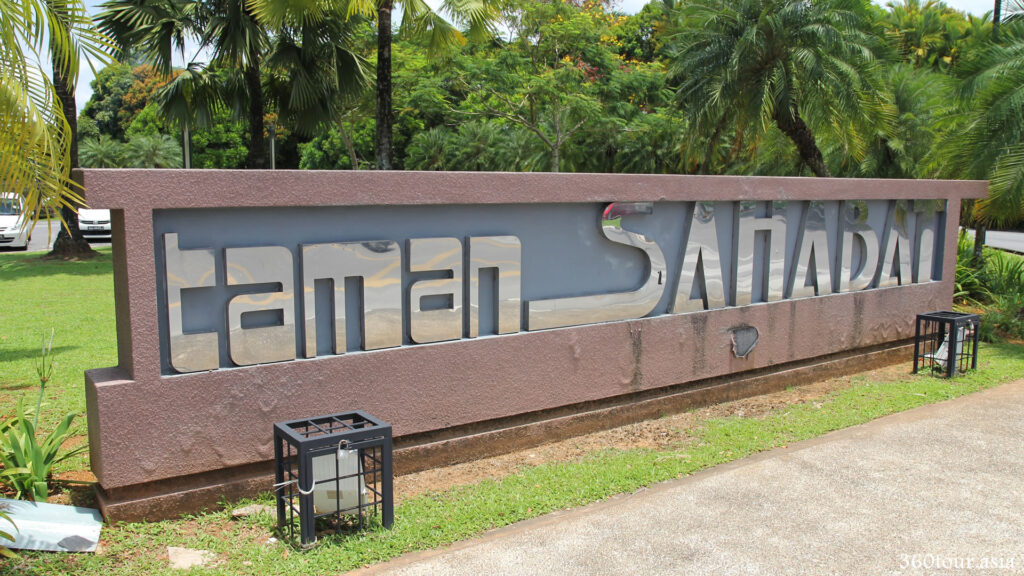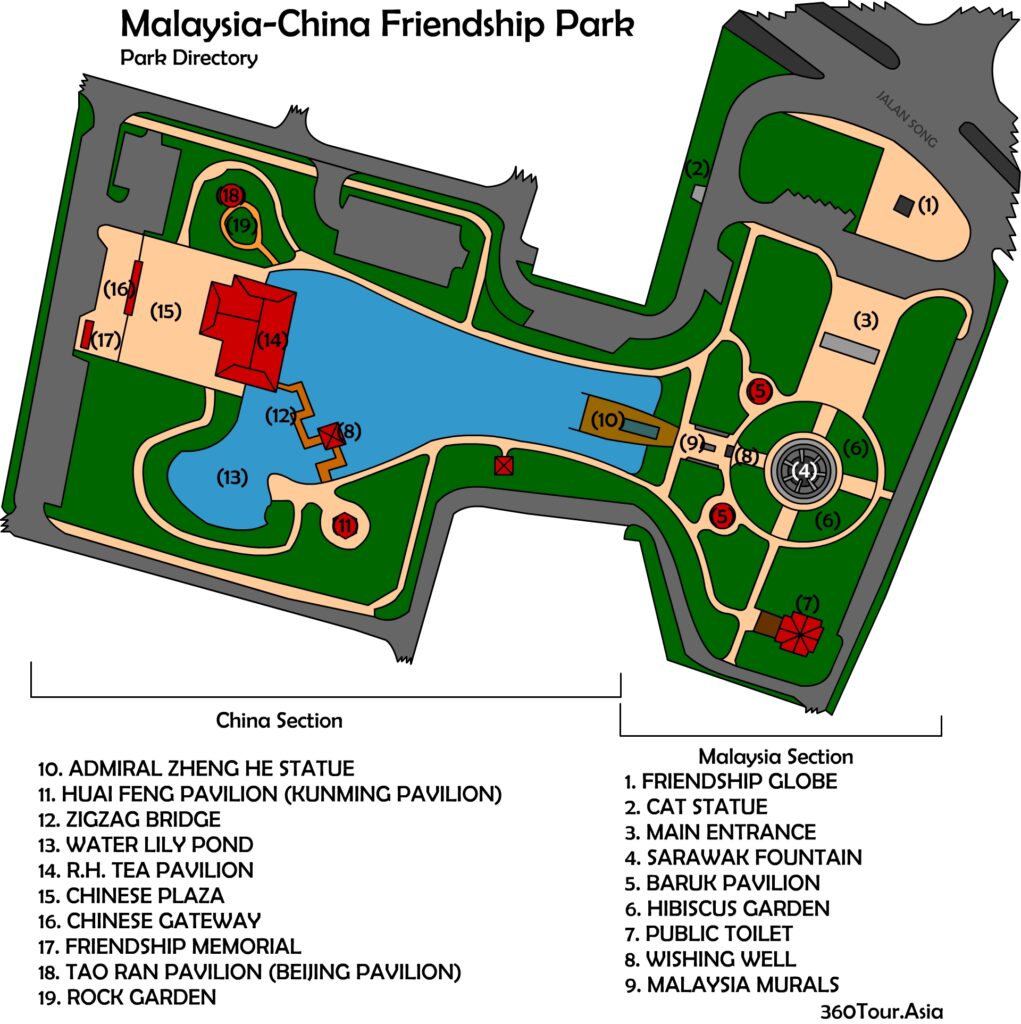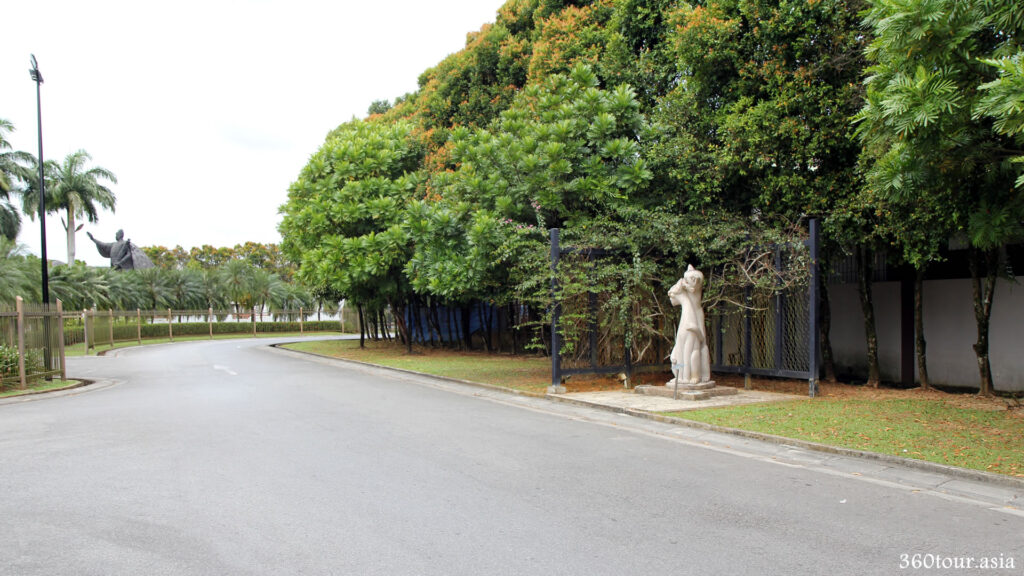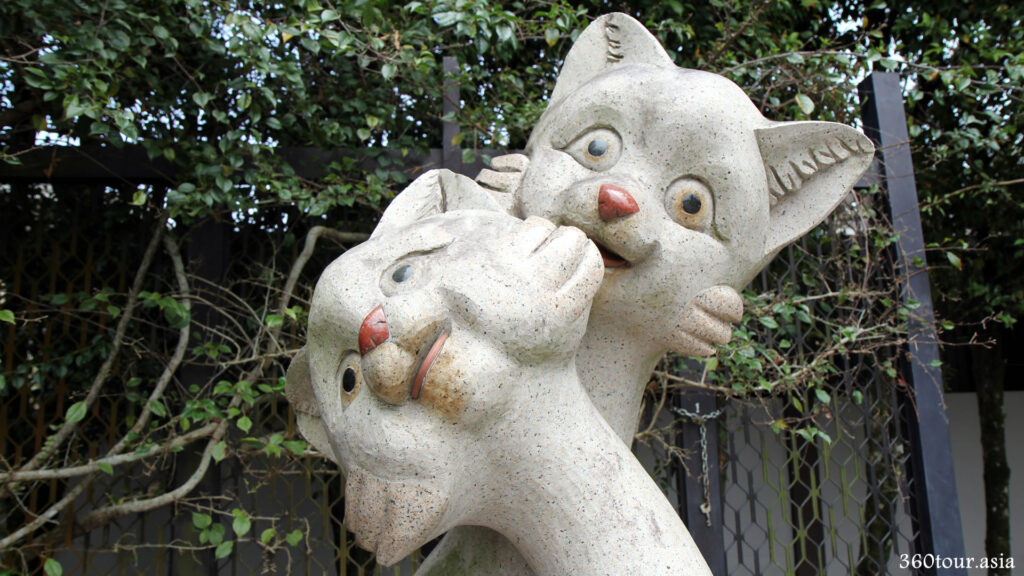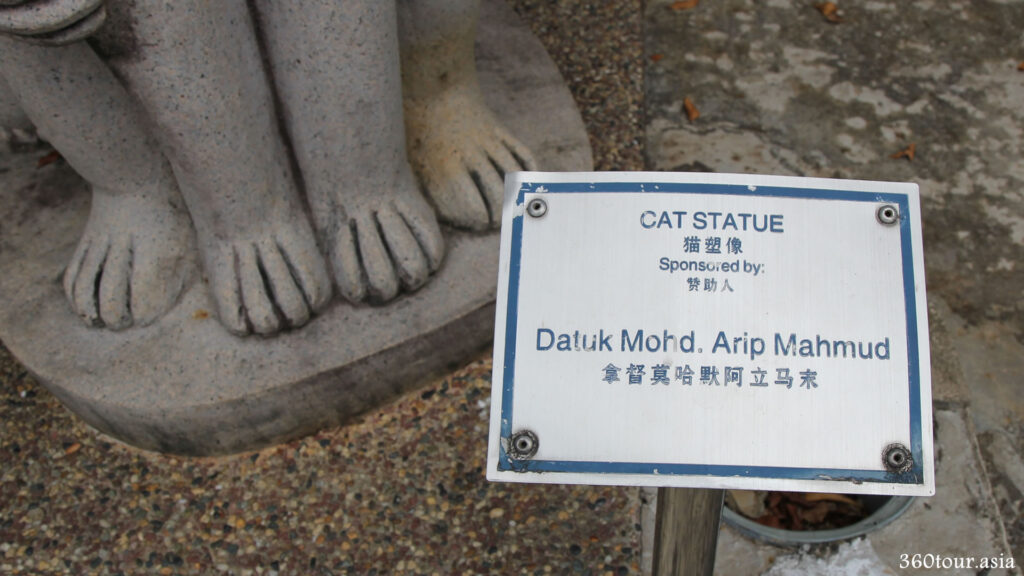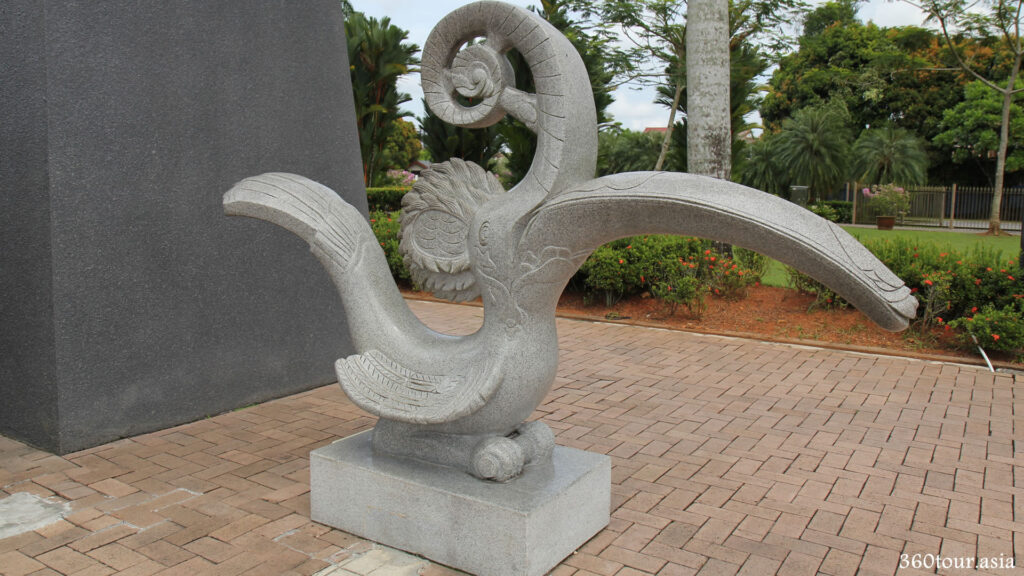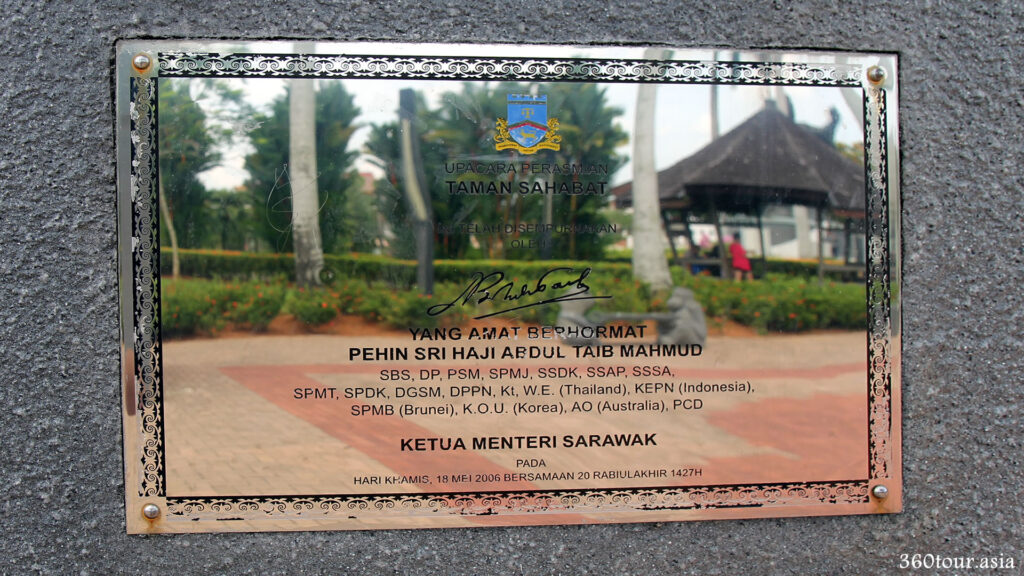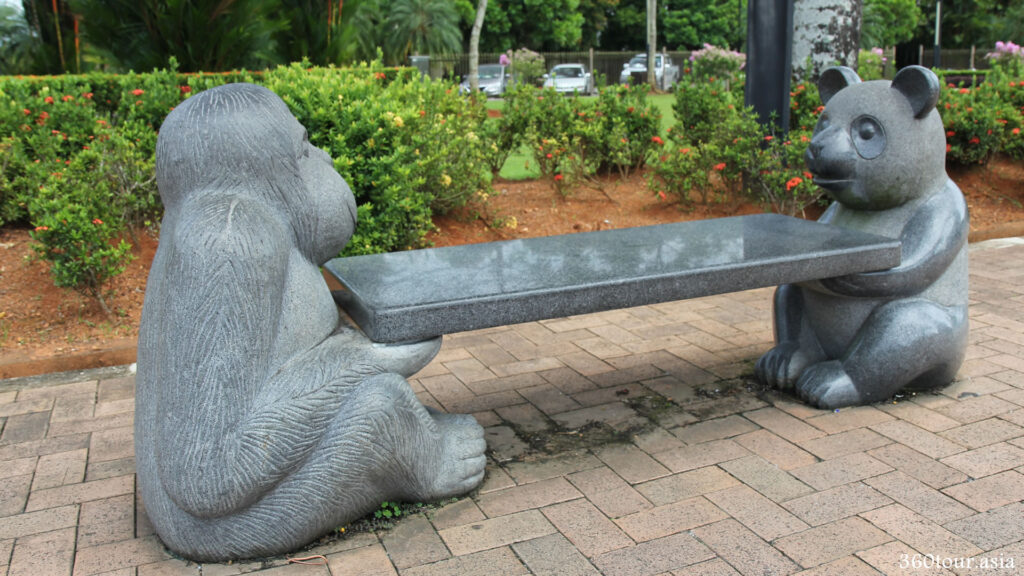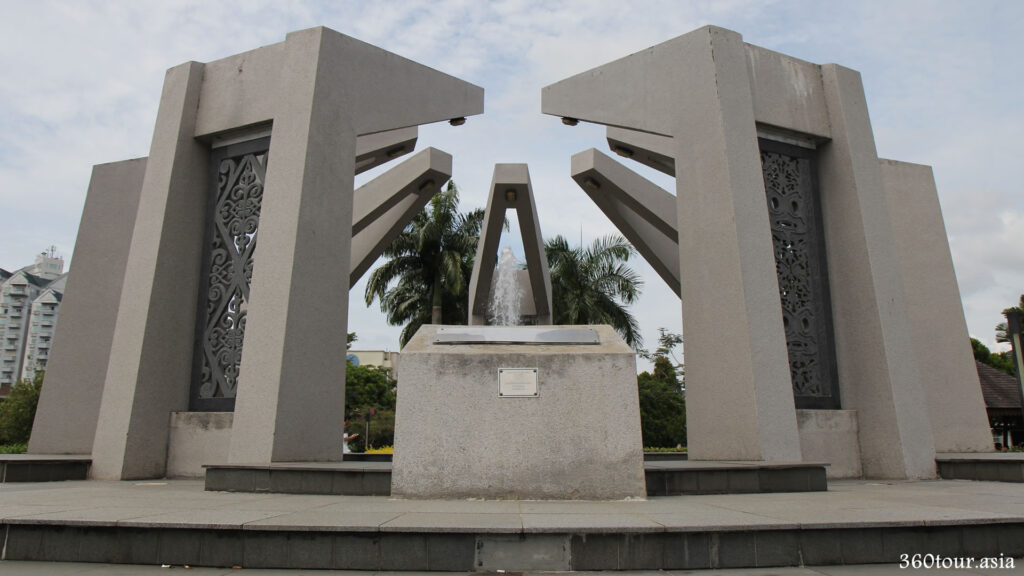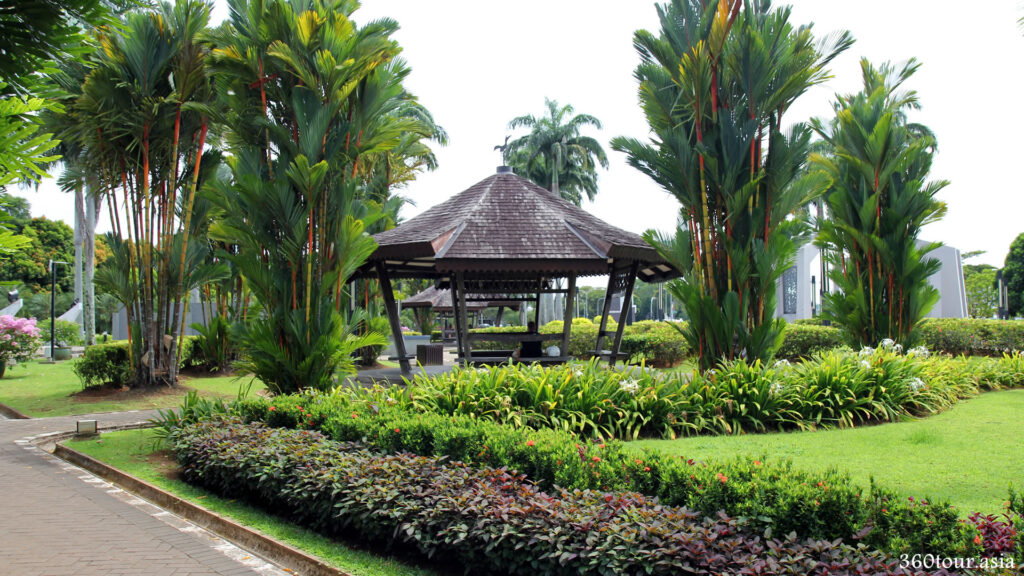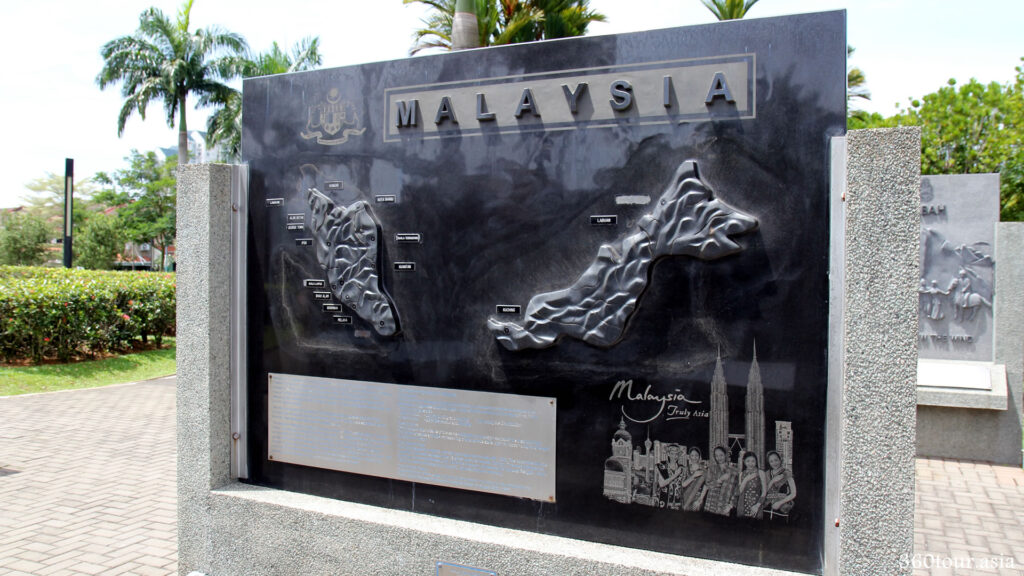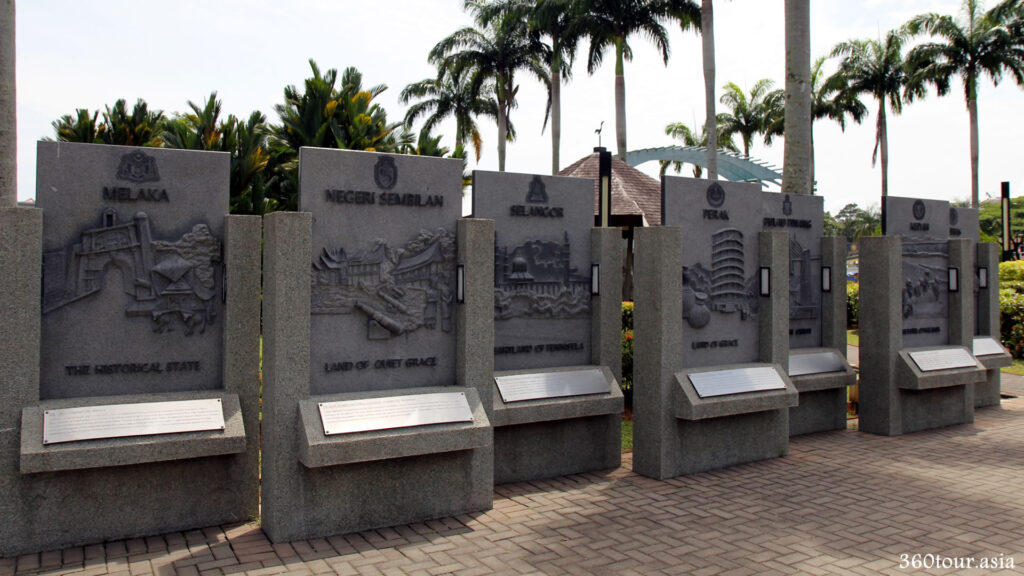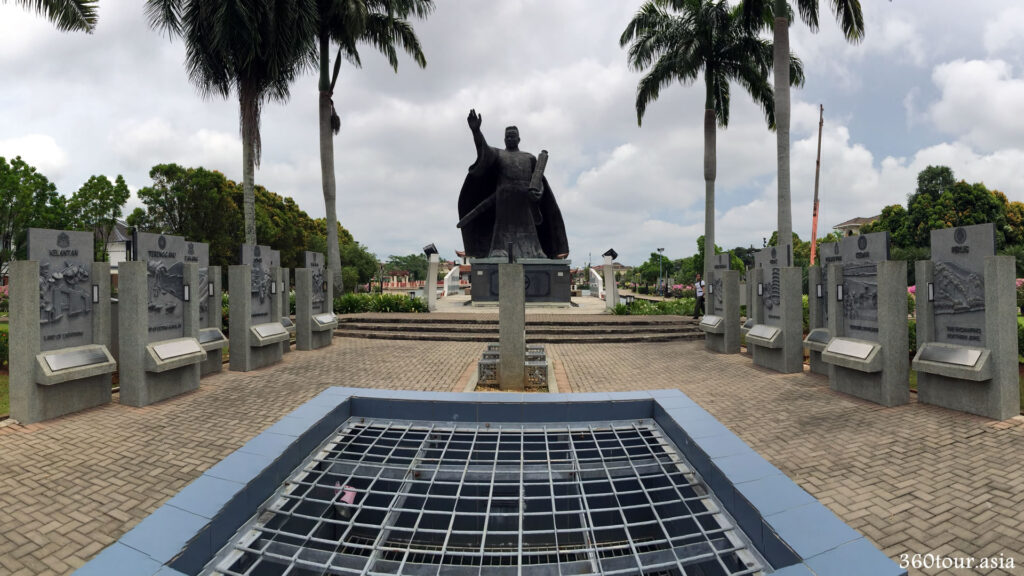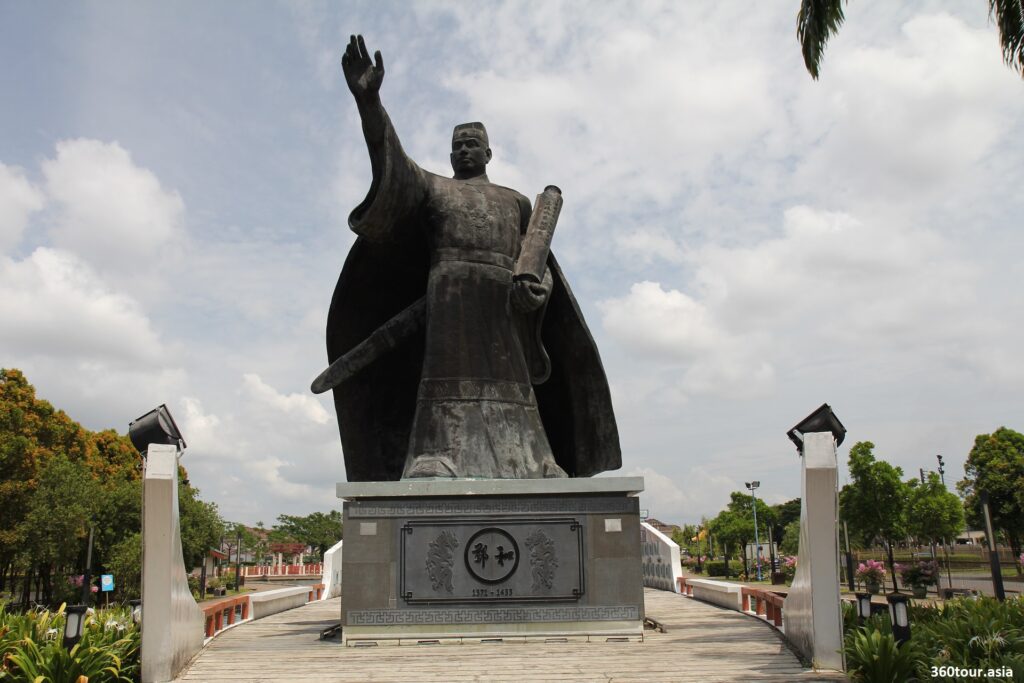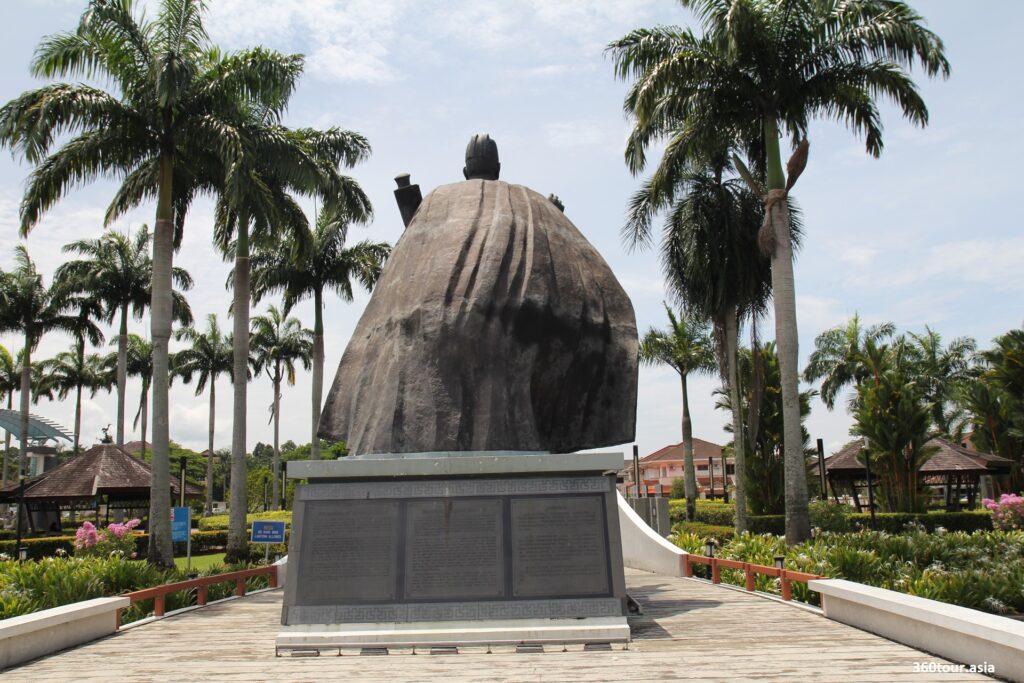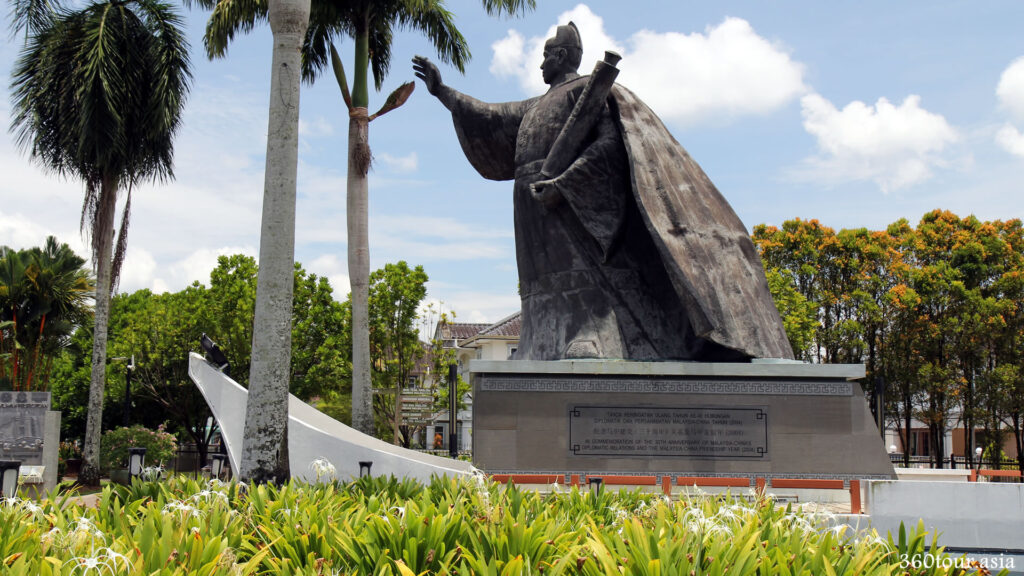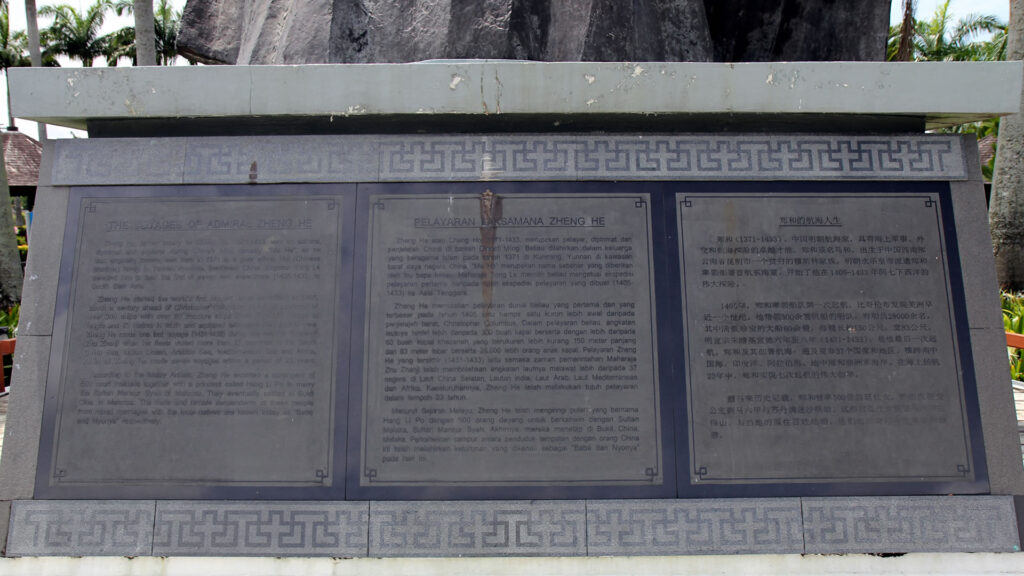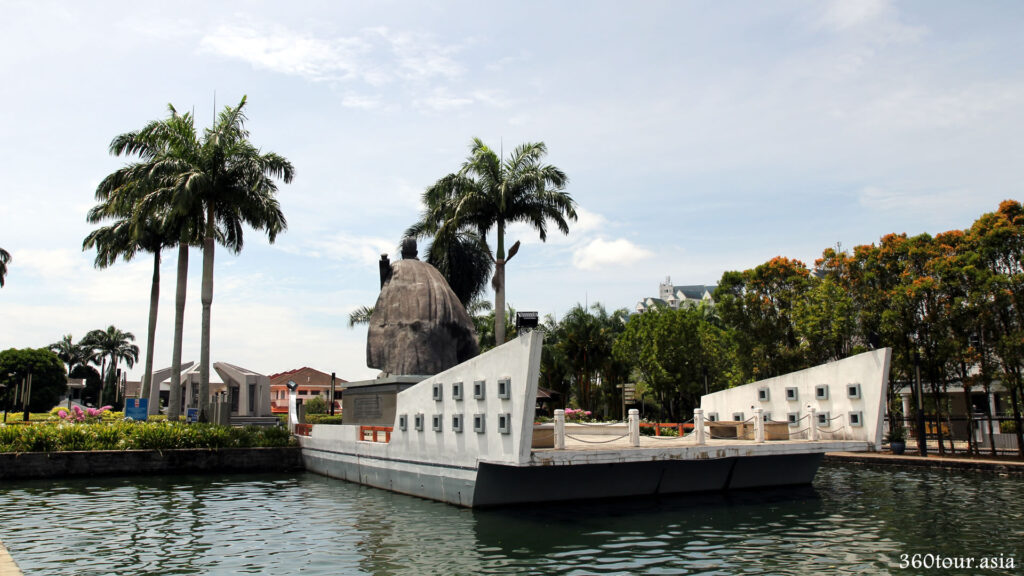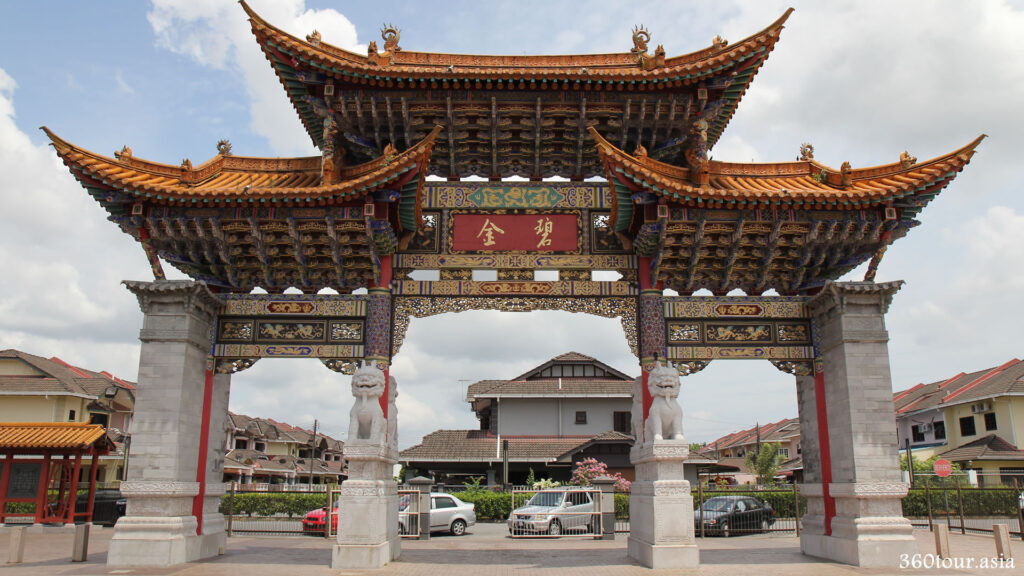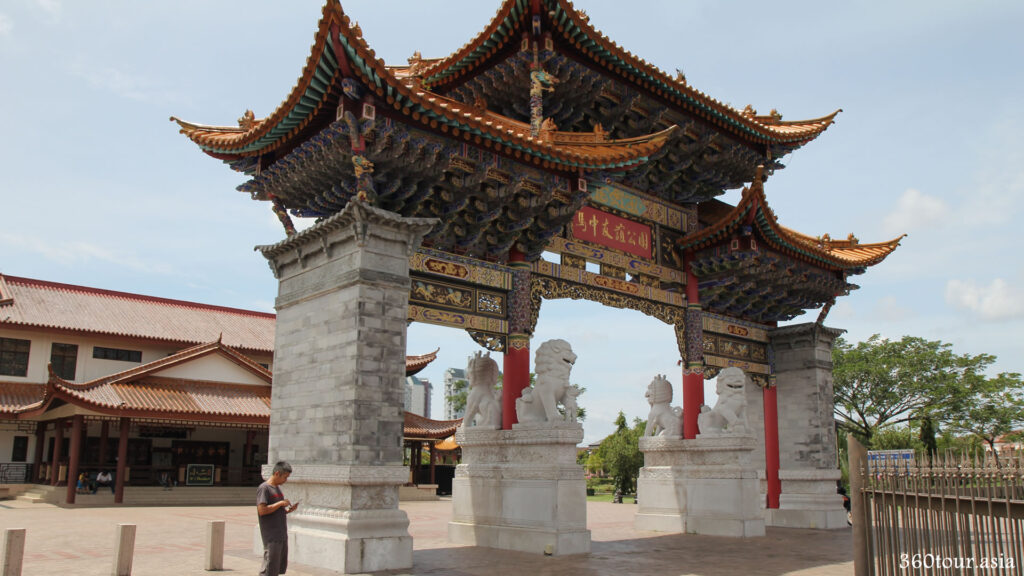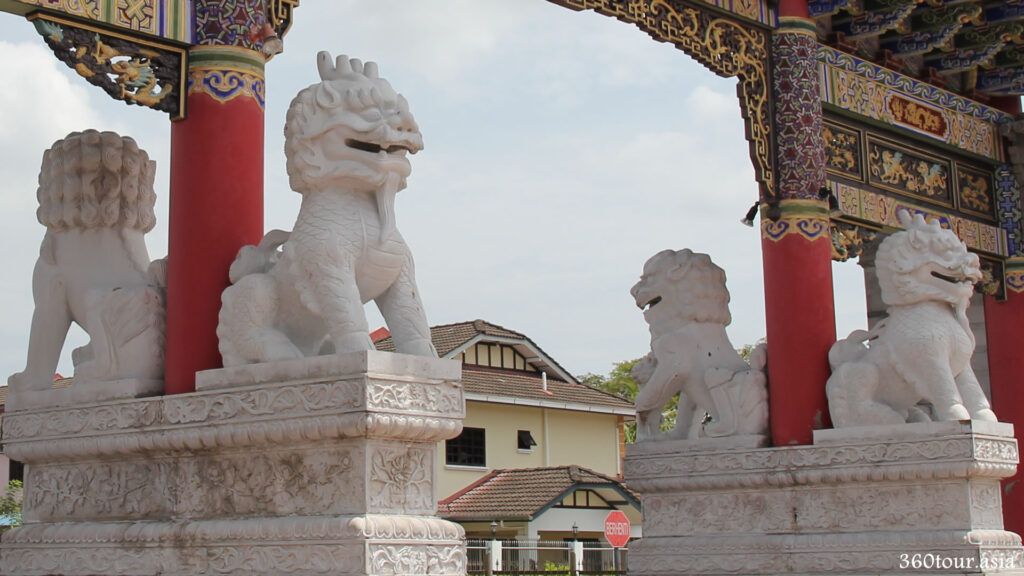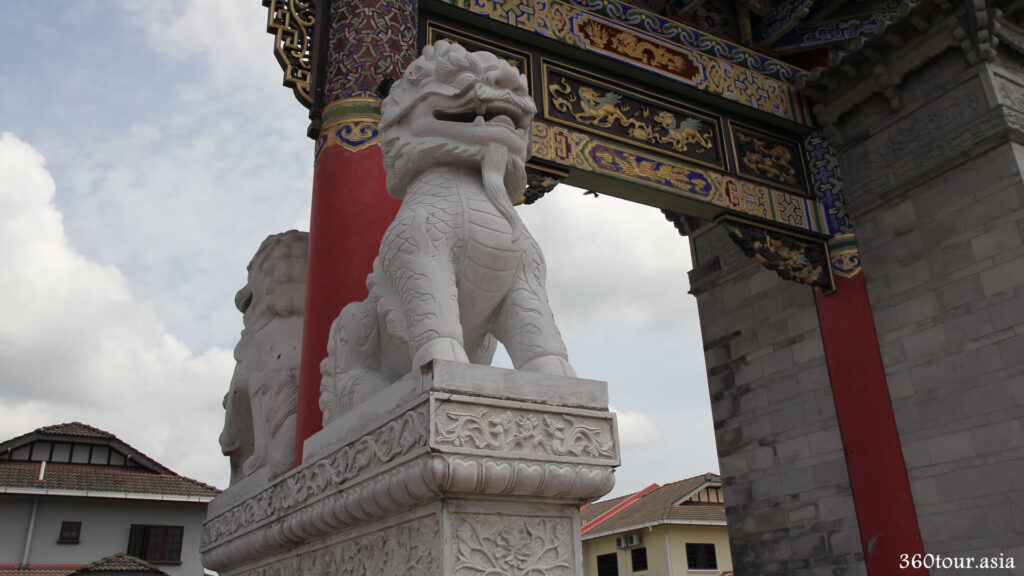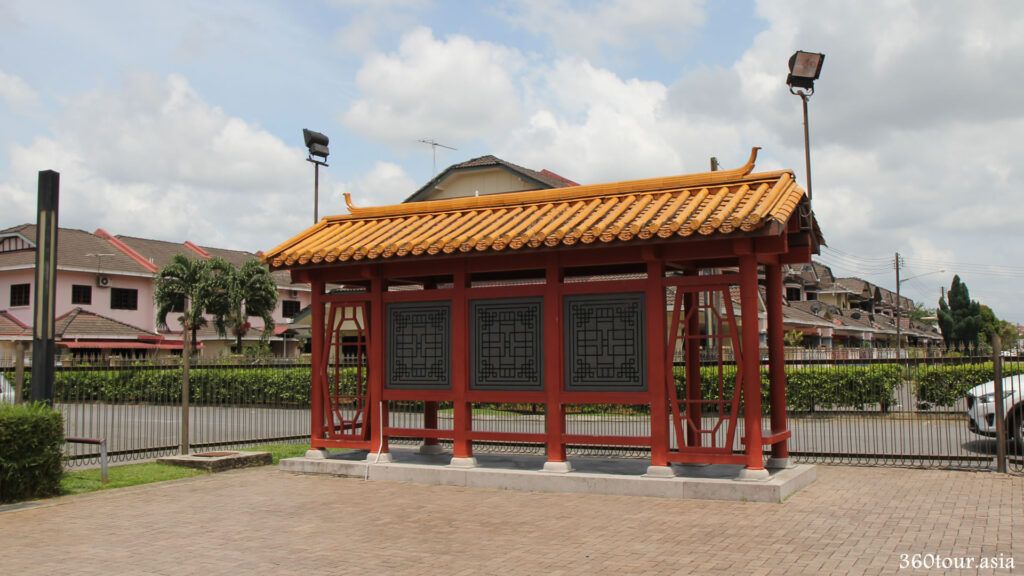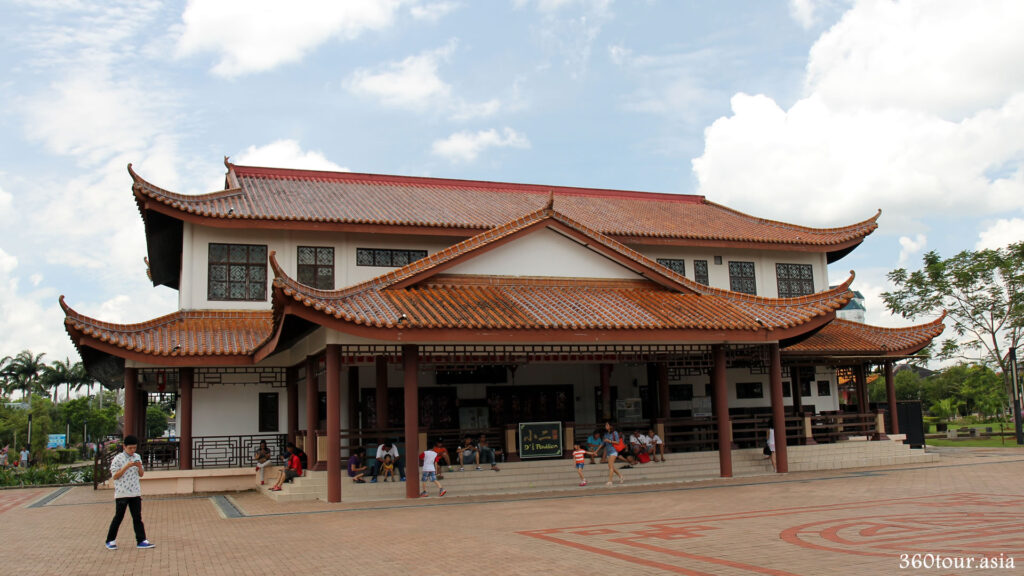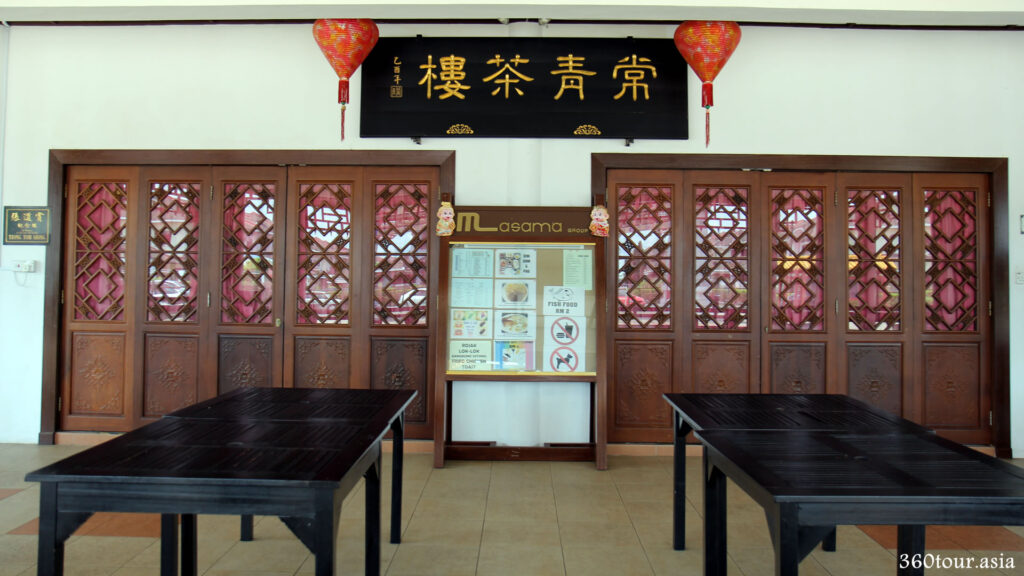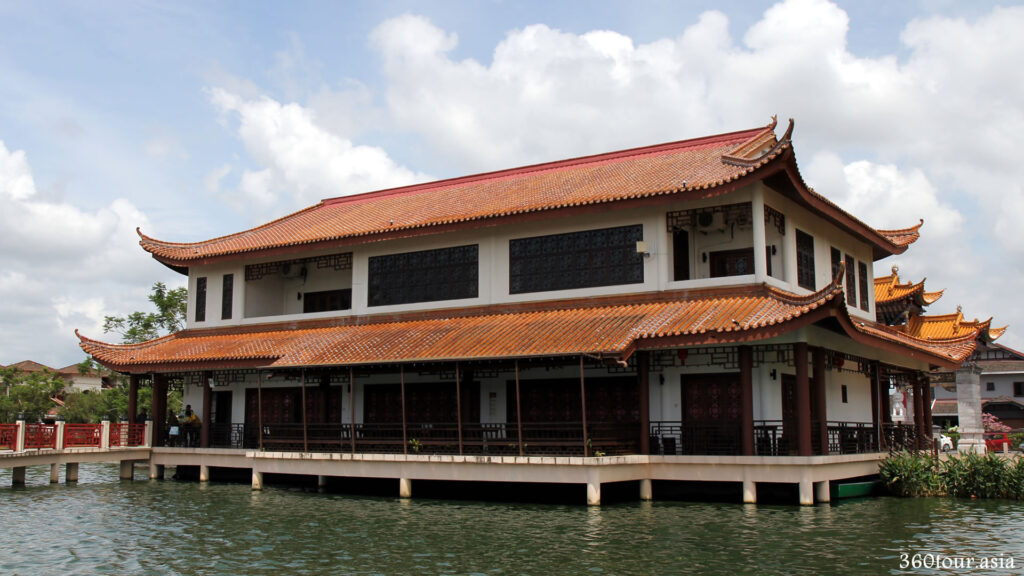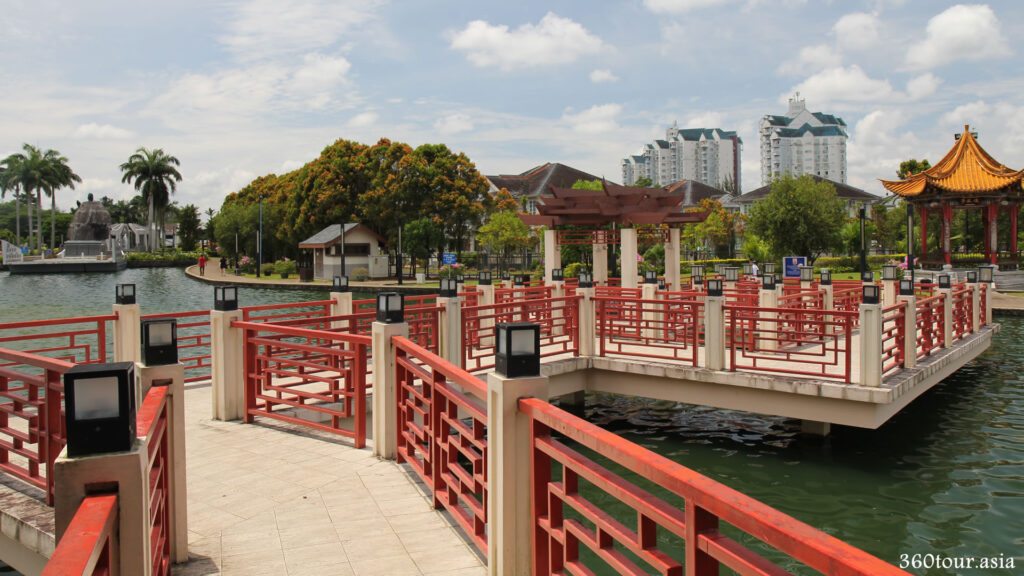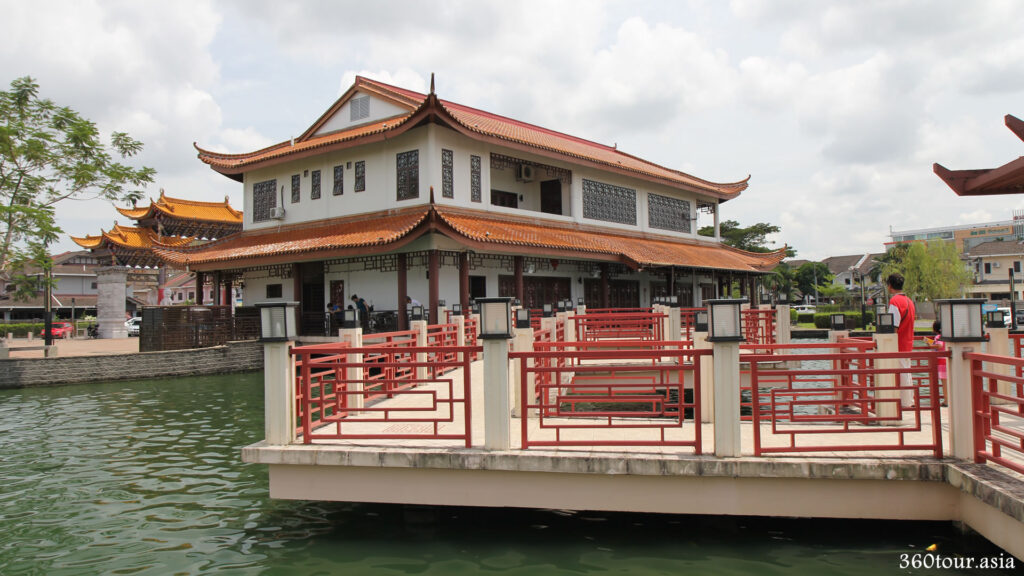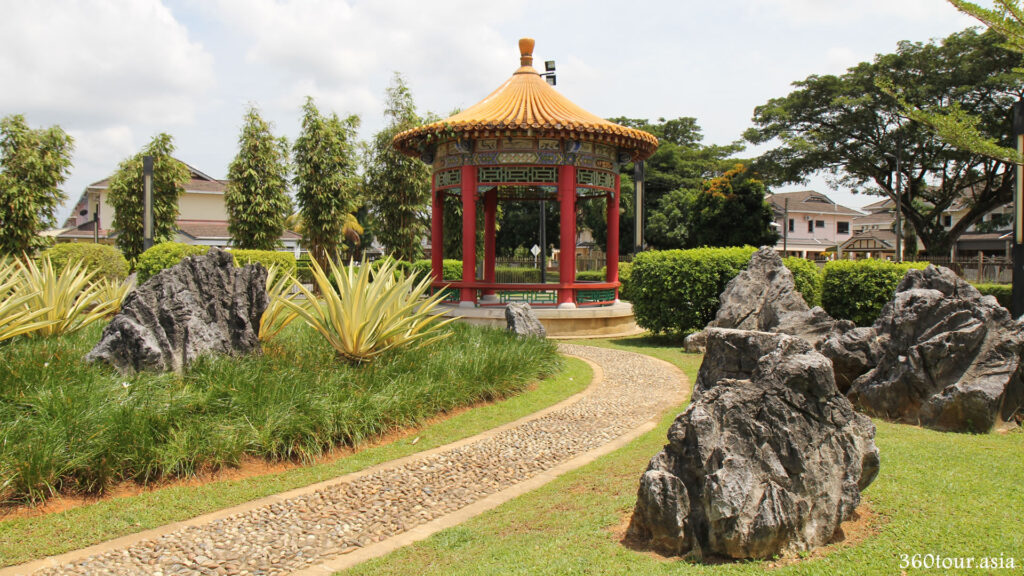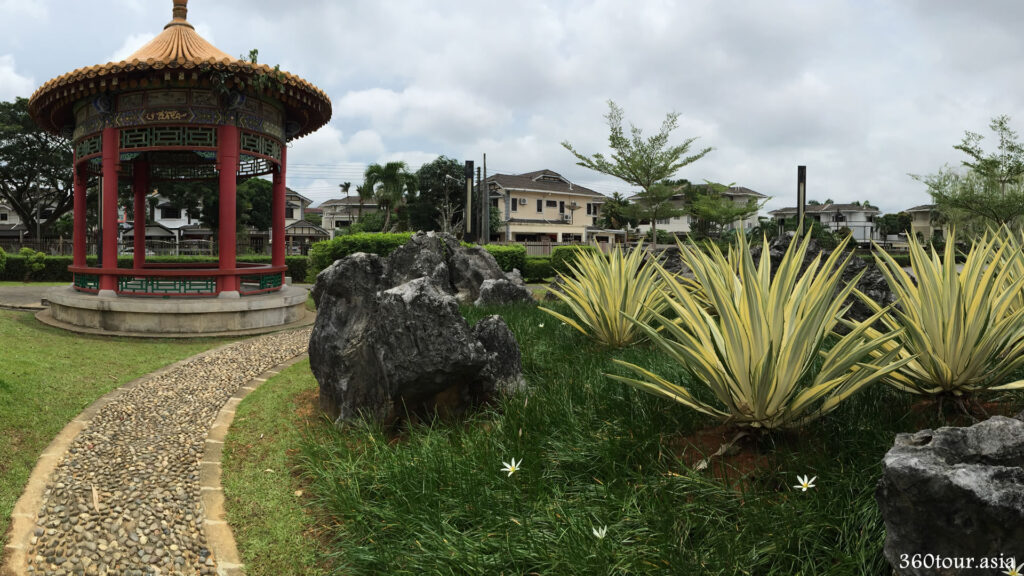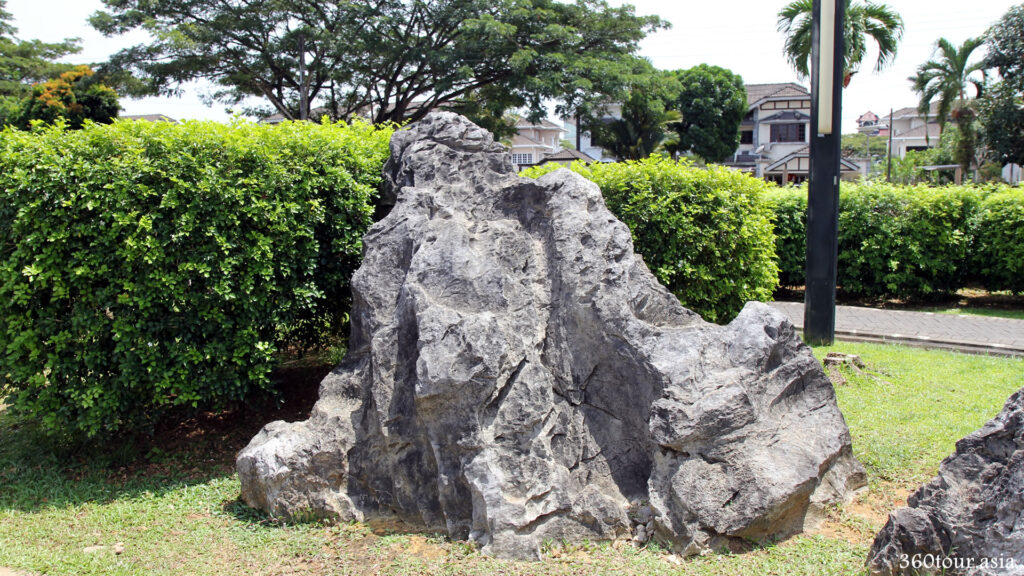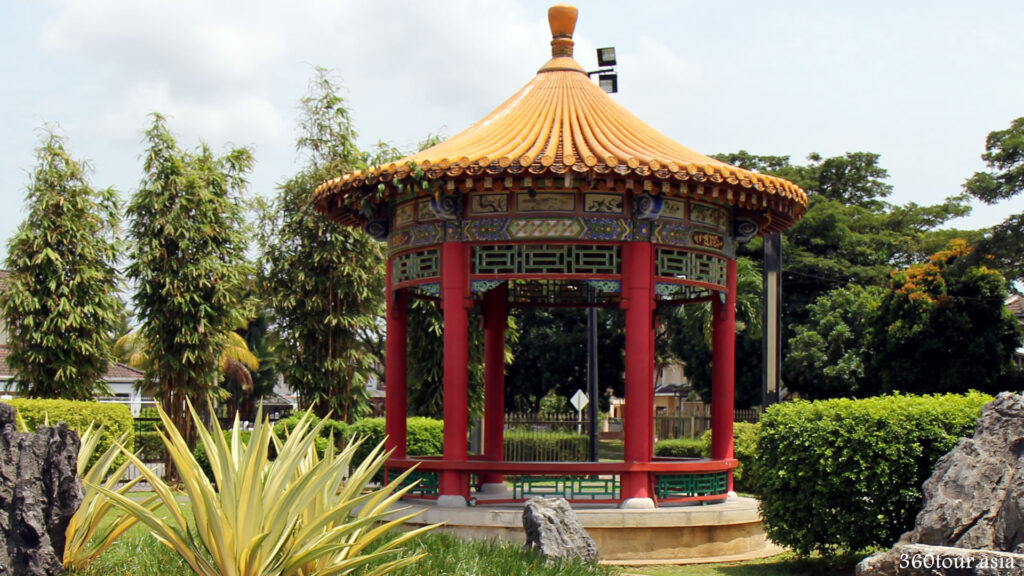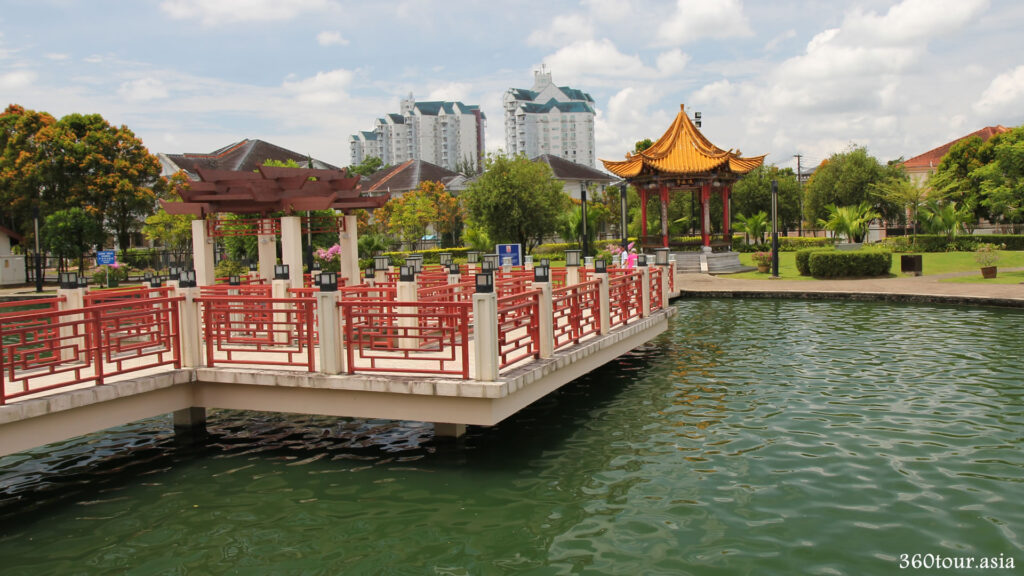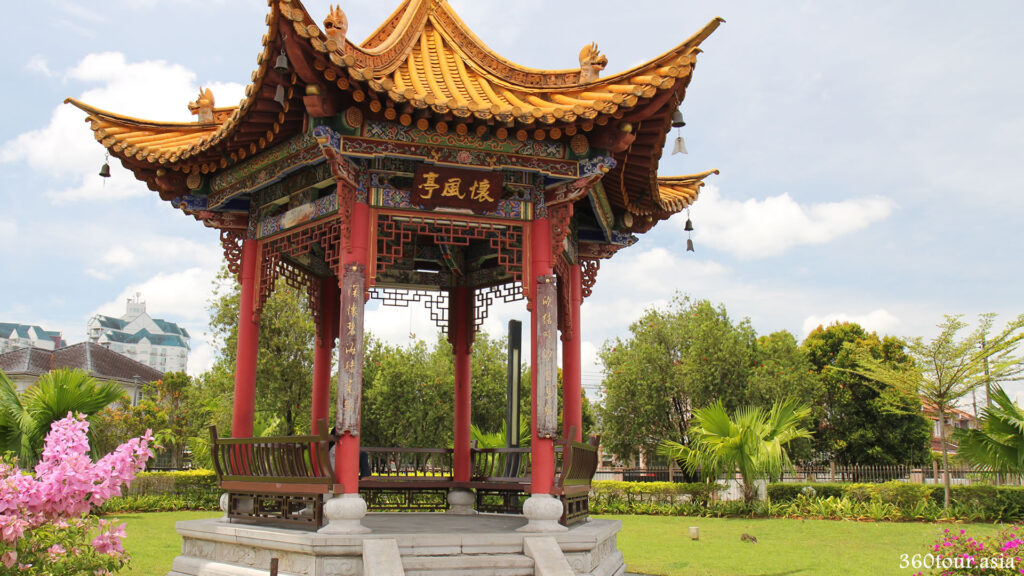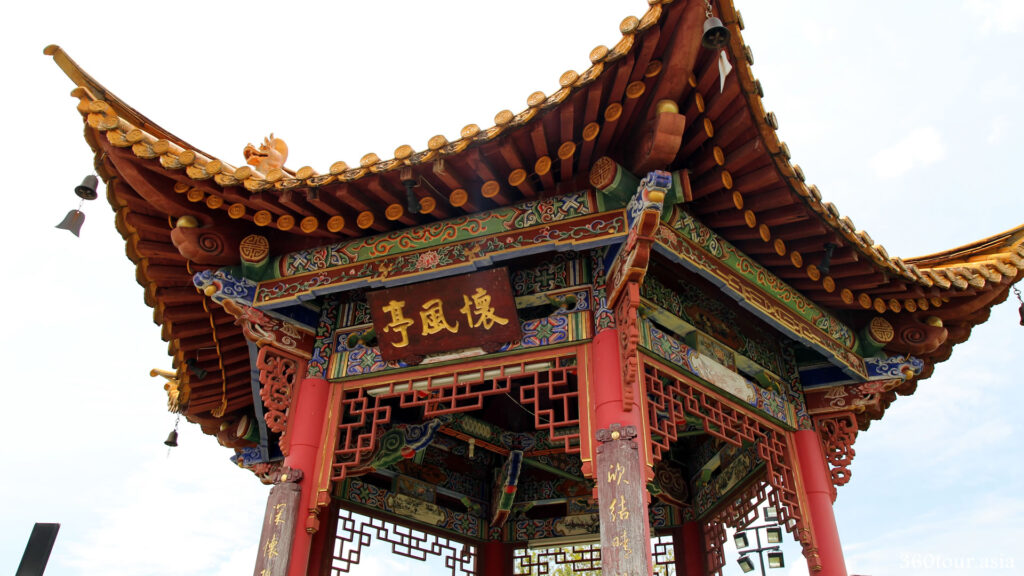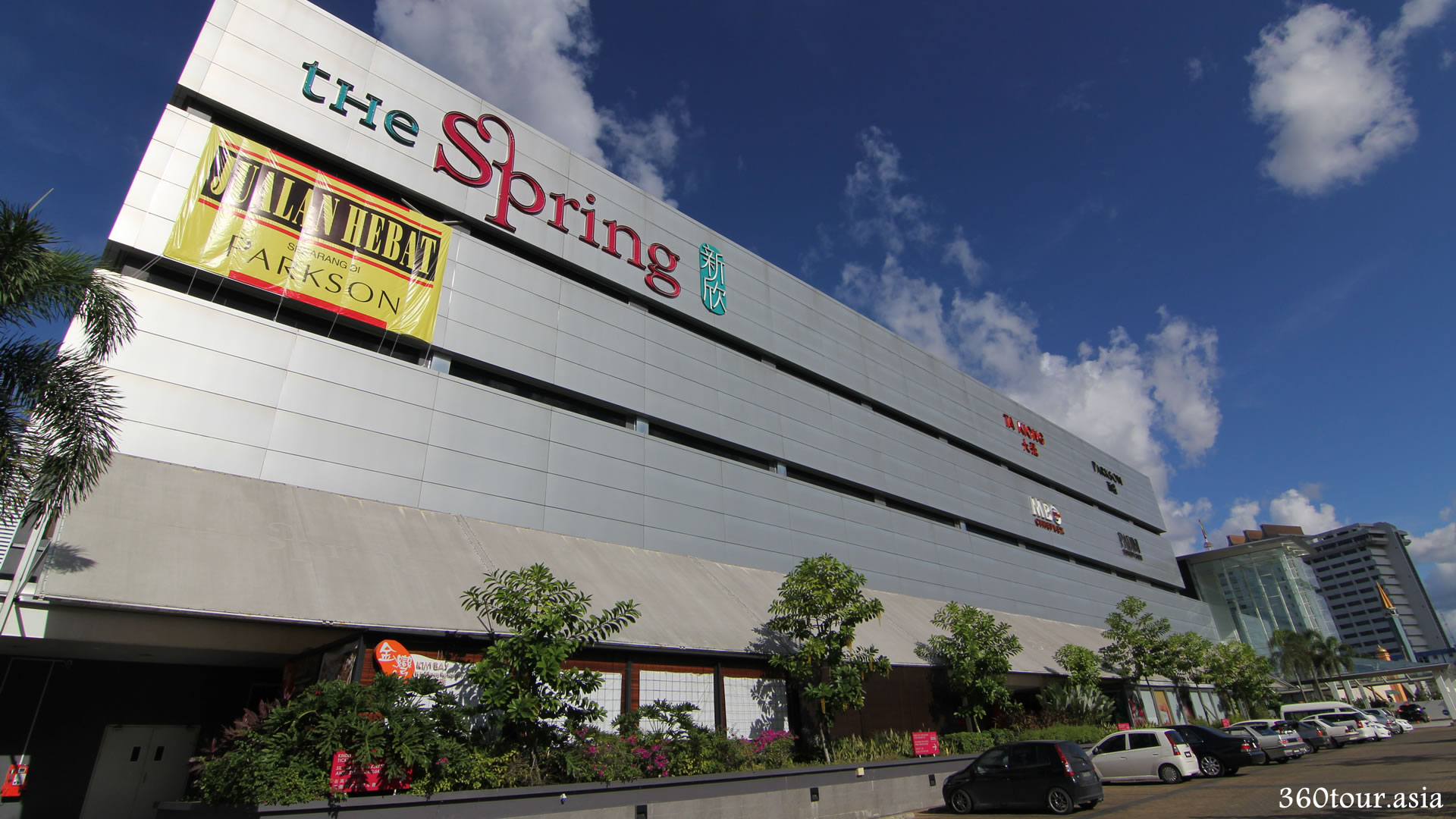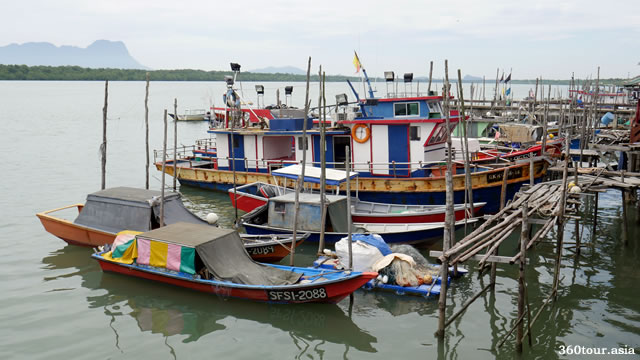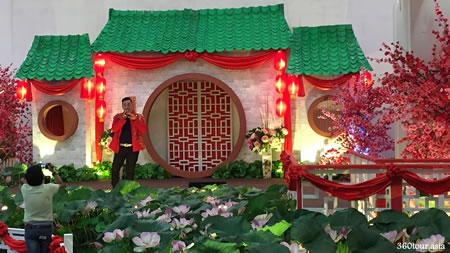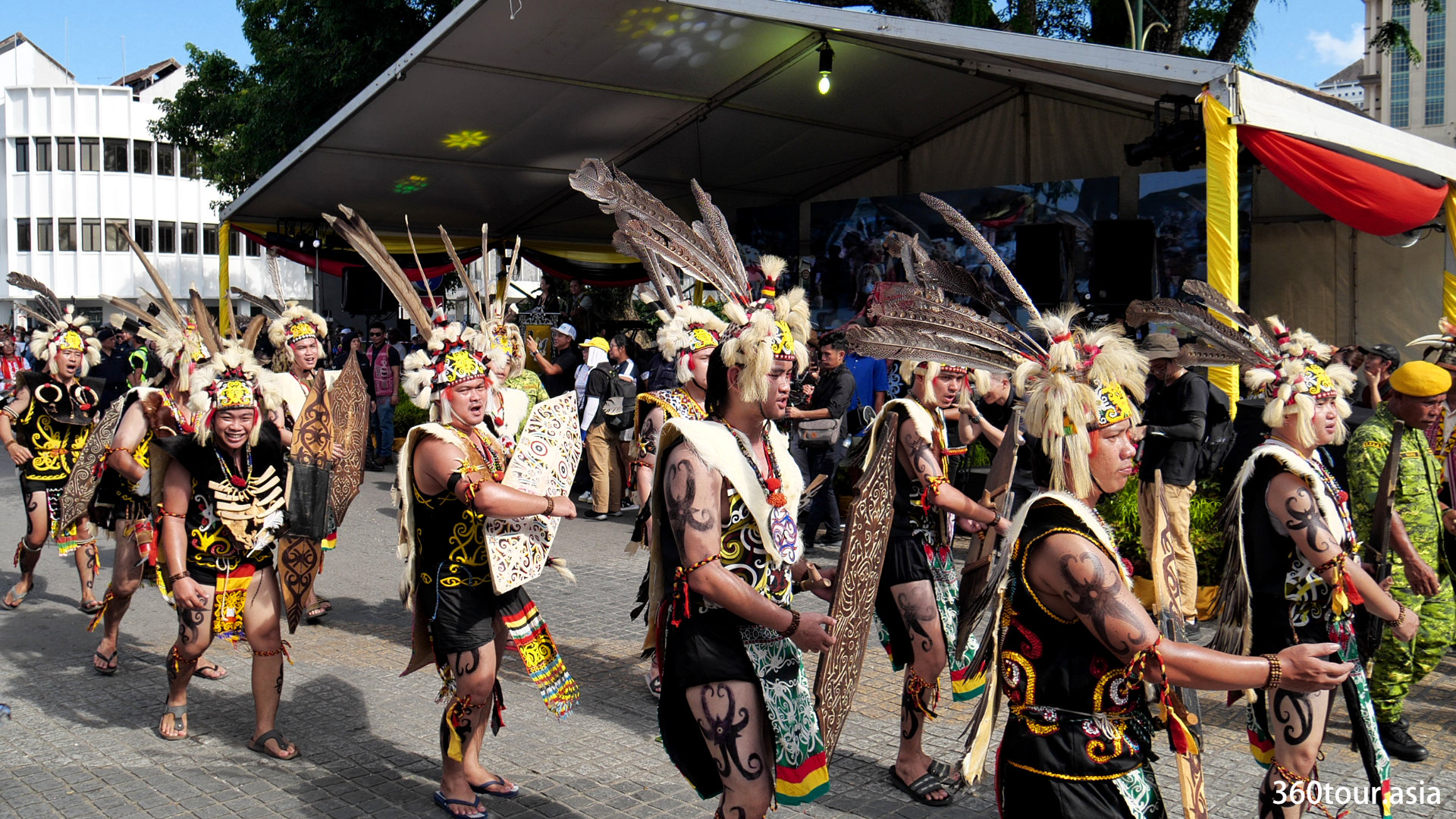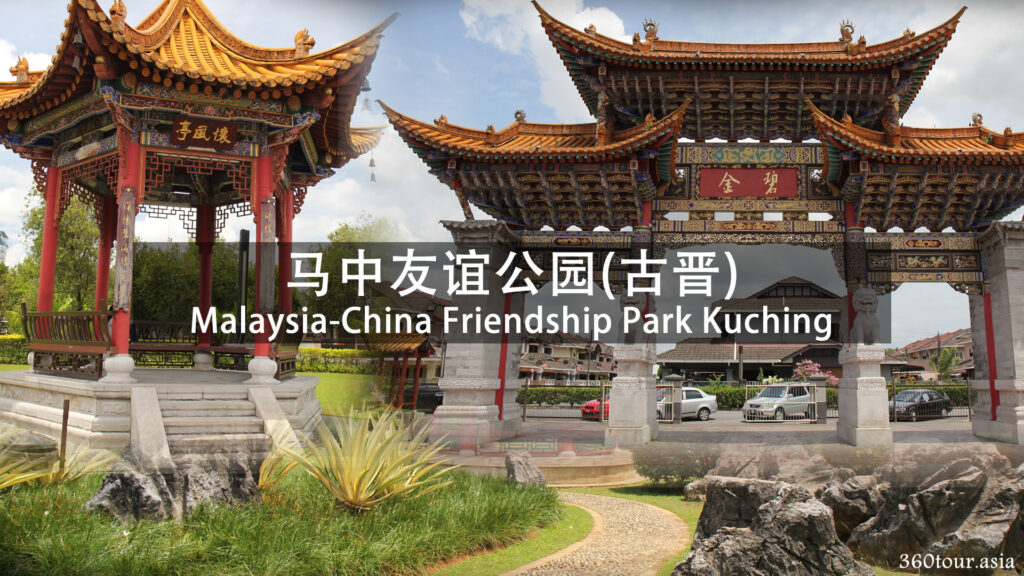
Other Name: Friendship Memorial, Friendship Park
Type: memorial park
Opening Hours: Daily 5AM to 12 midnight
Tel: 082-419 982
Address: Malaysia-China Friendship Park Kuching, Tabuan Heights, 93350 Kuching, Sarawak
Latitude : 1.5159859508668427
Longitude : 110.36690057353564
Open map with : [Waze] [Google Map] [Bing Map] [HERE Map]
Introduction
Malaysia-China Friendship Park also known as “马中公园” in Chinese or “Taman Sahabat” in Malay language, is a dedicated 2.8 hectares man made memorial park to commemorate the 30th anniversary of diplomatic relations between friendship between Malaysia and The People’s Republic of China since 1974. It was build during the Malaysia China friendship year 2004.
The famous inscription “Thousands of Miles Apart and Friendship is all it takes to bridge the distance.” can be seen on the Friendship Globe at the Park Entrance.
This park en-comprise of various elements of both Malaysian and China origins. Due to its many unique architectural-cultural presentation, This is one of the “not to be miss stop” for most tourist from near and afar.
This park is usually visited by locals, tourist and wedding photographers. The park is usually packed with Joggers in the early morning and late evening and even night time. The road around the park is nearly 2km in length.
The Friendship Park generally divided into two main section – The Malaysia Section and the China Section. It each had a cultural and architectural significant. The Wide lake signify the Wide Sea between China and Malaysia and Admiral Zheng He statue on the embarked Chinese Ship on the edge of the Malaysia Section signify its relationship between the two nations.
There are various rules and regulation while using the park. It is for the safety, convenience and cleanliness of the park.
Rules observed are as follows:
- This park is observed via a 24hours closed loop security camera system (CCTV).
- No Hawking.
- No Dogs are allowed in the park.
- Littering, Cycling, Swimming, Fishing, Pet, Motorcycle and Vandalism are strictly prohibited. Offenders will be prosecuted. The Council (Council of the City of Kuching South) shall not be liable for any injury, loss or damage caused to any person or personal belongings.
The Friendship Park Main Entrance
Located beside the junction of Jalan Song and Jalan Urat Mata, the Main Entrance of the Friendship Park can be clearly seen by the road side. The Friendship Globe and Cat Statue is the main attraction here. Visitors can many choice of parking scattered around the outer rim of the park, but each car park have limited space available.
Friendship Globe
Friendship Globe
The Friendship Globe is located at the open plaza at the main entrance of Friendship Park. It is a dark Marble carved sphere with laser imprinted image depict two leaders of nation holding hands as symbolic of diplomatic friendship in year 1974 and a background map of the two nations , China and Malaysia. There is a inscription “Thousands of Miles Apart and Friendship is all it takes to bridge the distance.” This Friendship Globe sits on a Granite carved Pedestal with block letter inscription “Malaysia-China Friendship Year 2004” and “Friendship Globe”, and a 3D motif of Phoenix and Dragon. This Globe is Sponsored by Ministry of Tourism Implemented by Majlis Bandaraya Kuching Selatan.
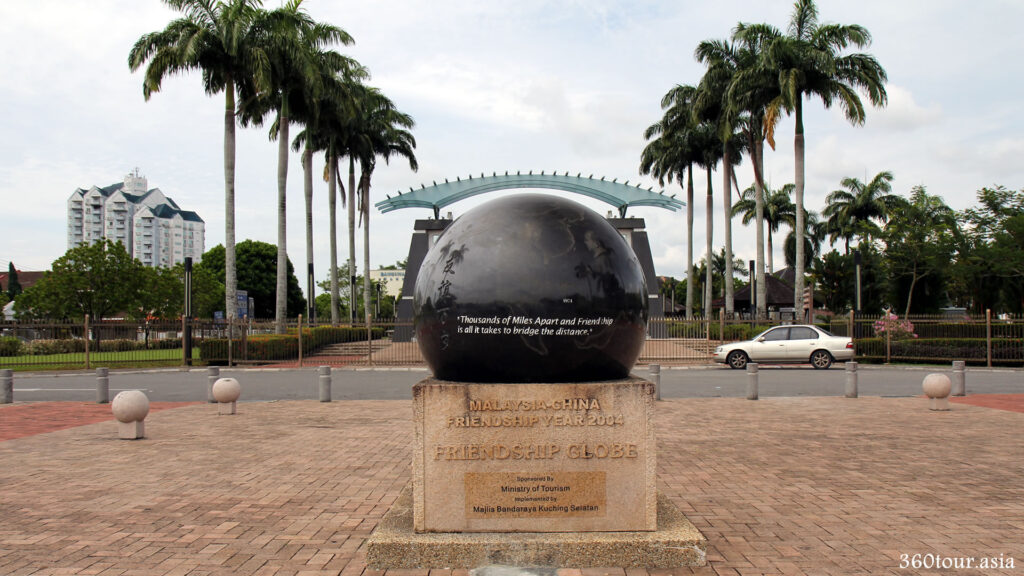
The Friendship Globe erected in front of Friendship Park , commemorate the Malaysia – China friendship year 2004.

The fine carved Marble Friendship Globe and the Granite Pedestal block in front of the Friendship Park.
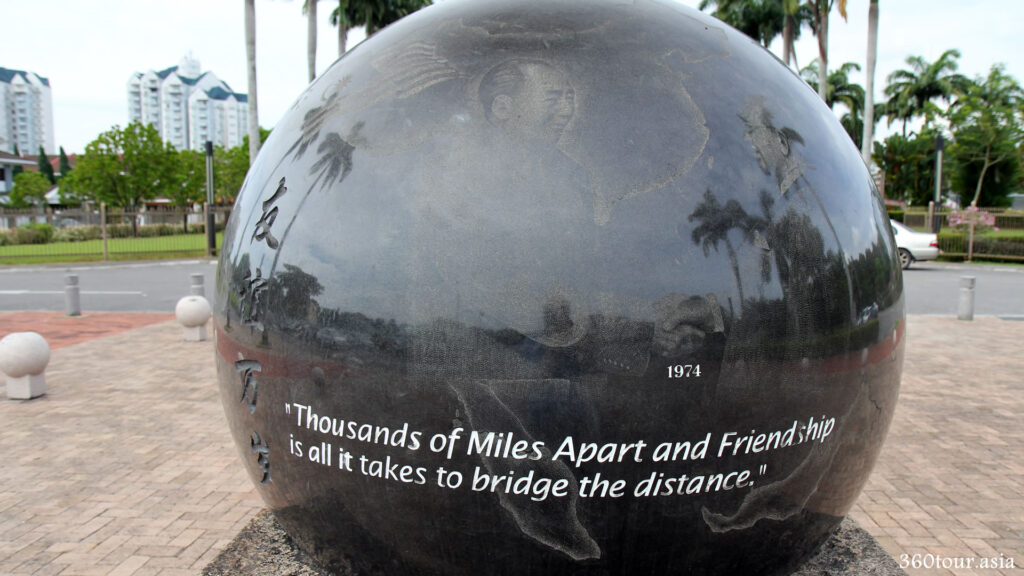
“Thousands of Miles Apart and Friendship is all it takes to bridge the distance.” carved on the Globe.
Some of the leaders shown on the globe are Tun Abdul Razak shaking hands with Mao Zedong and Abdullah Badawi shaking hands with Hu JinTao.
Romancing Cat Statue
Romancing Cat Statue
The “Romancing Cat Statue” located beside the entrance road to the Friendship Park greets every visitor who comes to the Park. The statue carved from marble stone block depict two adult cats in romance. One cat is holding the other cat within its arm, with a enjoy and indulging looks in their eyes. There is a inscription metal plate below the statue state that this statue is sponsored by Datuk Mohd. Arip Mahmud.
The Malaysia Section of Friendship Park
At the first part of the Friendship Park after the Main Entrance is the Malaysia section. It is called Malaysia Section because in holds the story and cultural representation of Malaysia.
At the Malaysia Section, the main attraction is the Main Entrance Gateway, Sarawak Fountain, Baruk Pavilion, Hibiscus Garden and Malaysia Murals.
Main Entrance Gateway
Main Entrance Gateway
The Main Entrance Gateway is a huge arch gateway facing the main road. It is a prominent feature as seen from the busy streets.
The Gateway is a modern-traditional fusion themed architectural structure that characterize with huge semi triangular cement pillars with sand blasted glass with traditional motive of the natives. The roof is a curved open metal arch. This fusion signify the modernization of Sarawak.
In front of the Gateway, there are two granite Hornbill statue. The Hornbill species of interest is Rhinoceros Hornbill which is a large species of forest hornbill that can be found in Borneo, Sumatra, Java, Malay Peninsular, Singapore and Southern Thailand. Rhinoceros Hornbill is the state bird of Sarawak, and the National Bird of Malaysia. Hornbill is seen in Logo of Sarawak state Government and Logo of Malaysian Government.
This Main Entrance Gateway is sponsored by Ibraco Berhad.
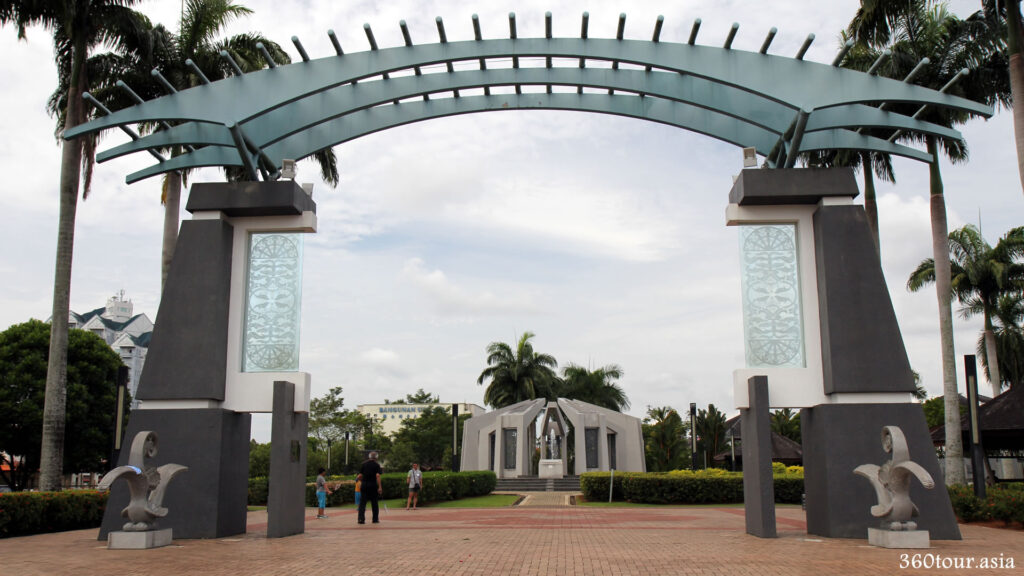
The Main Entrance Gateway as seen from front. The Sarawak Fountain is just located a few walks away behind the Gateway.
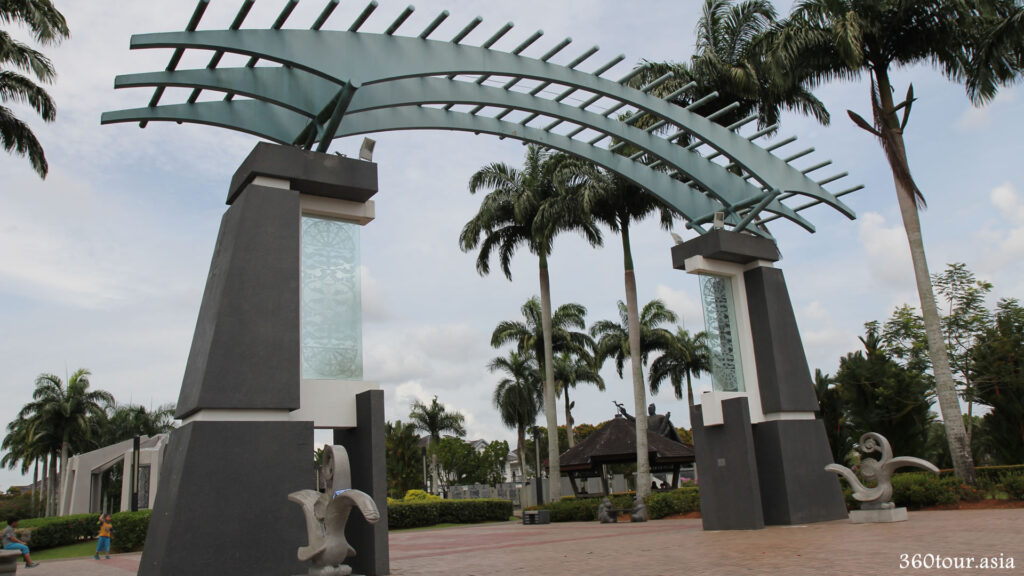
The majestic main entrance gateway as seen from the side. The two Hornbill statue is located in each sides of the gateway.
There is also a signage inscription plate that signify the opening ceremony of the Friendship Park is by Yang Amat Berhormat Pehin Sri Haji Abdul Taib Mahmud, the Chief Minister of Sarawak, on Thursday, 18th May 2006.
Panda and Orang Utan Statue
Panda and Orang Utan Statue
What are the protected animals that have unique significant to Malaysia and China ?
Visitor will notice a unique granite stone garden chair that is holding by a Orang Utan and Panda Statue. This holding signify a equal and balanced relationship between the two nations – Malaysia and China.
The Orang Utan are extant species of great apes that are native to Indonesia and Malaysia. It is found in Rainforest of Borneo and Sumatra. The name Orang Utan is derived from the Malay and Indonesian words which means “Person of the Forest”. Orang Utan are critically endangered species with estimated around 100,00 orang utans survived in the wild (IUCN 2016 estimates).
The Panda or known as Giant Panda, is commonly known as Black and White bear cat, is a species of bear native to south central china. This bamboo eating pandas are a conservation reliant vulnerable species. In 2007, reports showed 239 pandas living in captivity inside China. Internationally Giant Panda appears as a national symbol of China (apart from dragon). Panda is also used as “panda diplomacy” which marks cultural exchanges between China and other nations. Panda is also used as a logo of the WWF (World Wide Fund for Nature) as a world-wide recognizable icon in the field of the wilderness preservation and the reduction of human impact on the environment.
Both Orang Utan and Giant Panda are threatened by continued habitat loss and deforestation.
Sarawak Fountain
Sarawak Fountain
The “Sarawak Fountain” is located at central circle path at the first part of Friendship Park. It features seven granite pillars arrange in a circle with the top convergence at the center forms the apical center. At the center of the foundation there is a series of fountain projection over a stainless steel grill. At each of the pillars, there is a granite carved tablet with motif representing each of the ethnics in Sarawak. From this feature, the Massive statue of Admiral Zheng He can be seen across the park.
This signify the multi racial of Sarawak with each of distinct different cultural background that intertwined and hold strong. The seven major ethnic groups of Sarawak are the Malay, Chinese, Iban, Melanau, Penan, Orang Ulu and Bidayuh.

The Sarawak Fountain features seven granite pillars arrange in a circle with water fountain at the center.
This Sarawak Fountain Sponsored by Lee Onn Construction Company. At the inscription plate in front of this fountain depict the following:
As a Nation, Malaysia represents a successful example of unity in diversity. Its people have nurtured similarities but celebrated differences. Leading to a dynamic culture that is constantly evolving. This, in turn, has shaped the language, the arts, the way of living we see today – a potpourri of races and religions, cultures and traditions that has since melded into something that is truly, uniquely Malaysian.
Sarawak in particular, being the largest state in Malaysia has one of the country’s most ethnically diverse populations. This Monument celebrates the unity and the strength of Sarawak’s harmonious multi-racial society. This “Sarawak Fountain” groups the familiar artworks in granite carvings of seven major ethnic groups of the state, namely the Malay, Chinese, Iban, Melanau, Penan, Orang Ulu and Bidayuh. Seven representation that reaches to meet together at the apex of the sculpture, signifying the unity and confluence of ideas for the well being of the State. The fountain of random and impromptu spirits of water celebrate the Sarawak lifestyle of firm, joy and public participation. Granite is used to portray the natural strength of each community that will last forever.
Baruk Pavilion
Baruk Pavilion
The “Baruk Pavilion” is a circular rest hut located in the Friendship Park Kuching. There are actually two similar Pavilion at the edge of the circular path around the Hibiscus Garden and Sarawak Fountain. The design of the Pavilion mimics the native hut of Bidayuh House, Circular conical in nature with slanted beams and sharp roof. On top of the roof features a metallic hornbill ornament.
Malaysia Murals
The Malaysia Murals
The Malaysia Murals is a series of 3D granite carved murals representing travel and culture uniqueness from each state in Malaysia.
The inscription on the Malaysia Mural as follows:
Malaysia is a Federation of 13 states plus the Federal Capital of Kuala Lumpur and the Federal Territories of Labuan and Putrajaya. It was formed by the confederation of Malays, Singapore, Sabah and Sarawak on September 16th, 1963 (Singapore left in 1965). August 31st was later adopted as the National Day to coincide with the independence (Merdeka) Day of Malaya in 1957. Of the 13 states, 11 are one the Malayan Peninsular and 2 on the Borneo Island.
The states of Sabah and Sarawak in East Malaysia retain a greater degree of local administrative autonomy than the peninsular states, since they were separate colonies from the other Malayan States prior to independence.
The peoples of Malaysia comprise a number of different ethnic groups : Malay, Chinese, Indian, the indigenous Orang Asli of the Peninsular, the indigenous ethnic of Sabah and Sarawak and many of inter-racial marriages. There are at least 35 distinct ethnic groups from Sabah and Sarawak. These include Iban, Kadazan, Bidayuh, Malanau, Kenyah, Kayan, Dusun, Murut, Bajau, Kelabit, Bisaya, Lun Bawang and many others. This multi-racial character of Malaysia, with all the major religious affiliation, makes it the leading role model nation for the world trying to co-exist in diversity.
The National Symbols of Malaysia
Rukunegara:
This the Five Principles of Nationhood based on universal concepts acceptable to all Malaysians, regardless of ethnic origin. It was officially introduced on August 31st, 1970.
The five principles are:
- Belief in God
- Loyalty to King and Country
- Upholding the Constitution
- Rule of Law
- Good Behavior and Morality
Coat of Arms:
The Cresent-Star crest is of the same symbolism and design as that of the National Flag. The shield encases symbols representing of the various state, with the motto “Unity is Strength” in Malay and Arabic.
The National Flag:
This was designed by Mohd. Hamzah and approved on May 9th, 1950. The 14 stripes and the 14points of the star represent the 13 states plus the Federal Territory. The blue background at the top corner symbolizes unity, while the Cresent represents the National Religion, Islam. Yellow is used for the star and crescent, representing the monarchy.
The National Flower:
Originated from China, Japan and the Pacific Island, the hibiscus was designated by Tunku Abdul Rahman Putra as the national flower on August 18th, 1960.
The Sarawak mural
The inscription on the Sarawak Mural as follows:
Sarawak is the Largest state in Malaysia, covering an area virtually equal to the Peninsular. Historically its was a province of the Brunei Sultanate until the advent of the “White Rajahs, the Brookes” when it became an separate political entity. It became a British Colony in 1946, and in 1963, pledged its future in Malaysia as part of an independent nation. Its economic transformation, from the third poorest state in Malaysia (in 1963) to one of the richest today, says volumes about the tenacity of the people and their leaders, In all economic endeavor, Sarawak stands tall with the best in the Nation. It is also equally steadfast with great achievement in the sport arenas. Although Sarawak and Sabah on separate land mass from Peninsular Malaysia, they are proud of their roles and responsibility to ensure the success of the Nation.
The State Murals
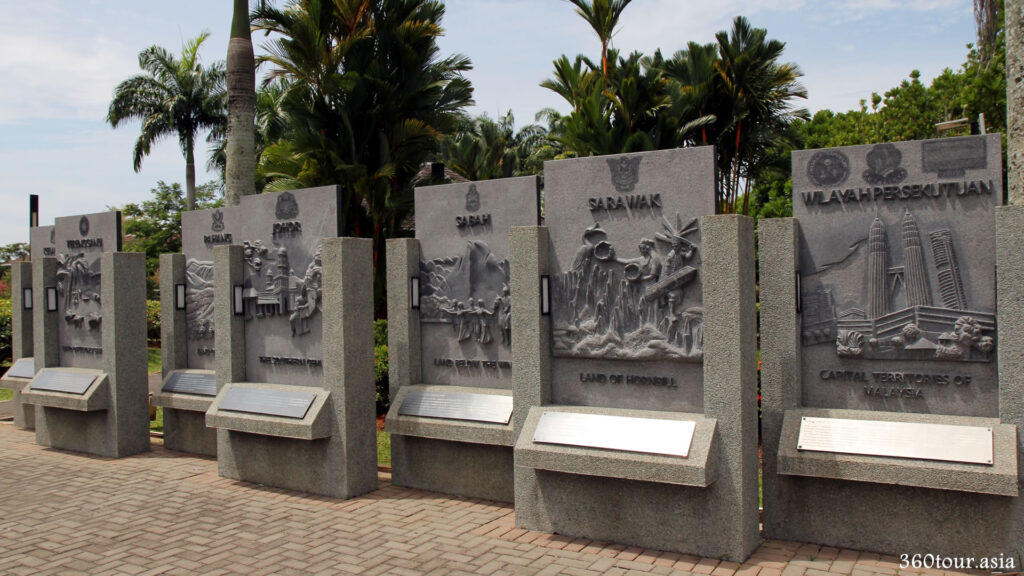
The State Murals is part of the Malaysia Murals with each state and federal murals representing significant cultural and landmarks.

From the Left : Johor (The Southern Gem), Sabah (Land Below the Wind), Sarawak (Land of Hornbill) and Wilayah Perseketuan (Capital Territory of Malaysia)
Johor is also known as “The Southern Gem”. The granite carving features the Sultan Abu Bakar State Mosque of Johor, which is an iconic of its architecture and age. The mosque is constructed between 1892 and 1900. Another feature of the mural is the locals holding a “Kuda Kepang” which is a cultural significant of the Traditional Flat Horse Dance.
At the inscription plate below this mural depict the following:
JOHOR DARUL TAKZIM – Capital City : Johore Bahru
Johor, the third largest state in Peninsular Malaysia is at its southern tip and its capital, Johore Bahru, lies just across the Straits of Johor from Singapore; the “Southern Gateway” to the Peninsular. The southern half of the renowned Endau-Rompin forest is in Johor (the northern half in Pahang). Johor’s political entity as successor state to the Melaka empire, developed further when it became a centre for trade, by strategic location between India and China. Johor is one of the fastest growth regions in modern Malaysia today.
Sabah is also known as “Land Below the Wind”. The granite carving features the majestic Mount Kinabalu of Sabah. Mount Kinabalu has been accorded UNESCO World Heritage status. Also in the granite carving are natives in traditional costumes and riding on horseback.
At the inscription plate below this mural depict the following:
SABAH – Capital City : Kota Kinabalu
Located at the north-eastern tip of Borneo, Sabah was reffed to as the “Land Below The Wind” by maritime traders because it lies below the typhoon belt. Sabah shares its western border with Sarawak and its southern one with Indonesia’s Kalimantan. The people of Sabah comprise about 32 distinct indigenous groups including Kadazan, Murut, Bajau, Kedayan, Sulu, Bisaya, Minokok and Rungus. In safeguarding its forest heritage, state parks and wildlife reserved have been set aside to provide sanctuaries for many near-extinct wildlife. Mount Kinabalu, the highest mountain in Southeast Asia, rises to 4,101 meters above sea level. Sabah is rapidly becoming an important tourist destination in Malaysia, with World’s Top 10 diving site at Pulau Sipadan, and many varied places, peoples and cultures of interest.
Sarawak is known as “Land of Hornbill”. The granite carving features the famous Pinnacles of Mulu National Park Sarawak. The Pinnacles are a collection of 45 metre high, limestone needles that cling to the side of Gunung Api (Fire Mountain). They are stark karst formations that are created as the soft limestone eroded away across millennia. Also in the granite carvings are the Rhinoceros Hornbill and native in traditional costume. The male holding sword and wooden shield (terabai) decorated with demon face, while the female holds Hornbill feather fans.
At the inscription plate below this mural depict the following:
SARAWAK – Capital City : Kuching
Along the north-western seaboard of Borneo, Sarawak is home to one of the world’s oldest tropical rainforests. It is previously known as “The Land of Hornbills” in tribute to the majestic looking hornbills, which are considered messengers from the spiritual world by the Iban community. Sarawak’s population comprises at least 25 distinct indigenous groups including Iban, Melanau, Malay, Bidayuh, Penan, Murut, Kenyah, Kayan, Kelabit, Lun Bawang and others. The non-indigenous include the Chinese and Indians, whose presence dated back over a thousand years. Sarawak offers the best potential in Malaysia in all fields, such as economy, tourism, education, agriculture, energy resources and industry.
Wilayah Persekutuan means Federal Territories. The Federal Territories in Malaysia comprise three territories: Kuala Lumpur (National Capital), Putrajaya (Administrative Capital) and Labuan (Offshore International Financial Center), governed directly by the federal government of Malaysia. The granite carving features the Petronas Twin Tower (tallest buildings in the world from 1998 to 2004), KLCC and the Maxis Tower besides.
At the inscription plate below this mural depict the following:
KUALA LUMPUR “Garden City of Lights”
Kuala Lumpur, Malaysia’s eclectic charming capital is situated centrally on the West Coast of Peninsular Malaysia. The city began as a mining town in the late 1800s with the discovery of tin at confluence of the Klang and Gombak rivers, It was subsequently called Kuala Lumpur meaning “muddy confluence”. It was proclaimed city status on 1 February 1972, and declared a Federal Territory in 1974.
PUTRAJAYA “Malaysia’s Futuristic City”
Putrajaya is Malaysia’s stylish futuristic city. Named after the nation’s first Prime Minister, the late Tunku Abdul Rahman Putra al-Haj, the 4581 hectare ‘Garden City’ with intelligent electronic connections and features is the new administrative capital and was declared as a Federal Territory in 2000.
LABUAN “Malaysia’s Financial Offshore Centre”
Labuan is the largest of a cluster of six islands situated off the west coast of Sabah. On April 16, 1984 Labuan was declared a Federal Territory and subsequently an International Offshore Financial Centre (IOFC) on Oct 1, 1990.
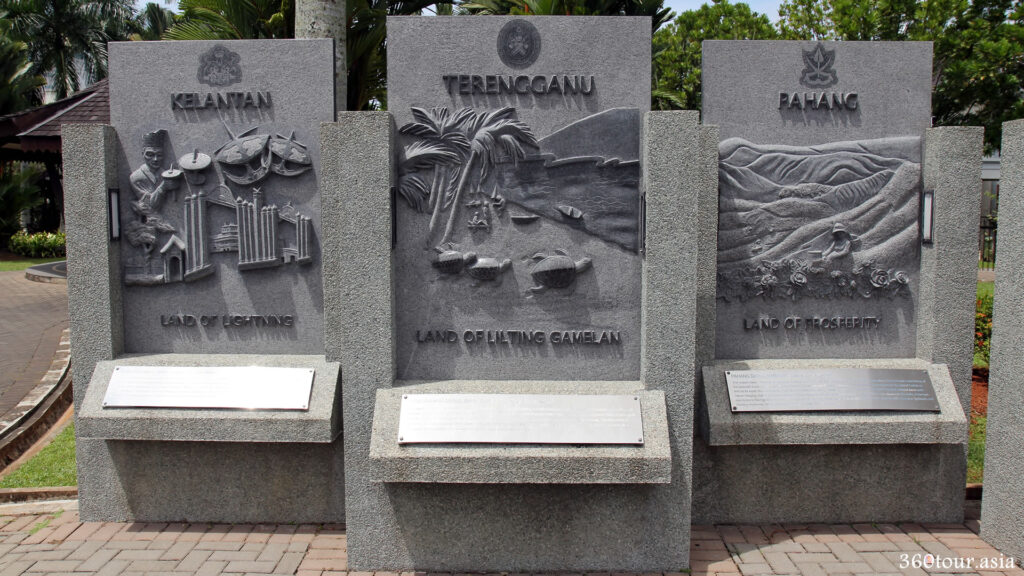
From the Left : Kelantan (Land of Lightning), Terengganu (Land of Lilting Gamelan) , Pahang (Land of Prosperity)
Kelantan is also Known as “Land of Lightning”. The Kelantan granite carving features traditional games of Gasing (Malay Spinning Top) and Wau (Malaysian Traditional Kite). The most common games of spinning top is “memangkah gasing” where two or more players compete to strike each other’s top out of a circle or to make others to fall over or stop spining. In the game of Wau, the most notable one are Wau Bulan (Malaysian Moon-Kite), other variants includes Wau Kuching (Cat Kite) and Wau Merak (Peacock Kite), all are distinguishable from their lower section of the kite. These type of Kite is usually huge and decorated with floral motifs. Another feature in this granite carving is the Kelantan Royal Palace Gate at Istana Jahar (Ceremonies Museum) , uniquely appears as multiple high pillars.
At the inscription plate below this mural depict the following:
KELANTAN DARUL NAIM – Capital City : Kota Bharu
Located in the north-eastern corner of the Peninsular, Kelantan is an agrarian state with lush padi field, rusting fishing villages and cauarina-lined beaches. It is primarily a Malay state although a small part of the population are Thai, Indian and Chinese ancestry. Its history was, at various times, influenced by Sri Vijaya Kingdom, Melaka, Thailand, Terengganu, and the British. Kelantan is well known for its traditional Malay handiwork, silverwork, silver and gold embroidering (songket), batik etc. Its traditional pastimes include kite-flying (wau), top spinning (gasing), bird singing (merbok) competitions and shadow plays (wayang kulit).
Terengganu is also known as “Land of Lilting Gamelan”. The Terengganu granite carving features a scene of beautiful seaside with coconut trees and sea turtles roaming around the beach.
At the inscription plate below this mural depict the following:
TERENGGANU DARUL IMAN – Capital City: Kuala Terengganu Terengganu is one of the Malaysia state endowed with a wealth of charming and refreshing natural landscapes. She boasts miles of sandy beaches, exotic island, lush virgin tropical jungle, quaint fishing village, dazzling waterfalls and many more. Terengganu’s history goes back to as far as the 1st century and has long been an important area of Malay settlement (even before the rise of Melaka). The discovery of petroleum and natural gases off its coast in the late 1970s boosted the social economic development of the state. It is also famous for its hatcheries for the leatherback turtles that lay their eggs along the East Coast.
Pahang is also known as “Land of Prosperity”. The Pahang granite carving features a scene of a beautiful hill landscape of Cameron Highland, which is famous for its tea growing, vegetable farms and flower nurseries.
At the inscription plate below this mural depict the following:
PAHANG DARUL MAKMUR – Capital City: Kuantan
The largest state in Peninsular Malaysia, Pahang is home to some of Malaysia’s premier holiday destinations. From its east coast facing of the splendid South China Sea to its mountainous forest interior, Pahang is famous among locals and foreigners for its natural habitat as well as its exotic flora and fauna. Tropical rainforests dominate the state, which is also the site of Malaysia largest national forest park – Taman Negara. Half of the Endau-Rompin Forest Reserve, a world renowned largely unexplored forest, is situated in this state. Pahang is also home to the highest mountain in the Peninsular, Gunung Tahan. Other famous hill resorts include Fraser’s Hill, Cameron Highlands and Genting Highlands. Off shore Pulau Tioman is a great Tourist attraction.
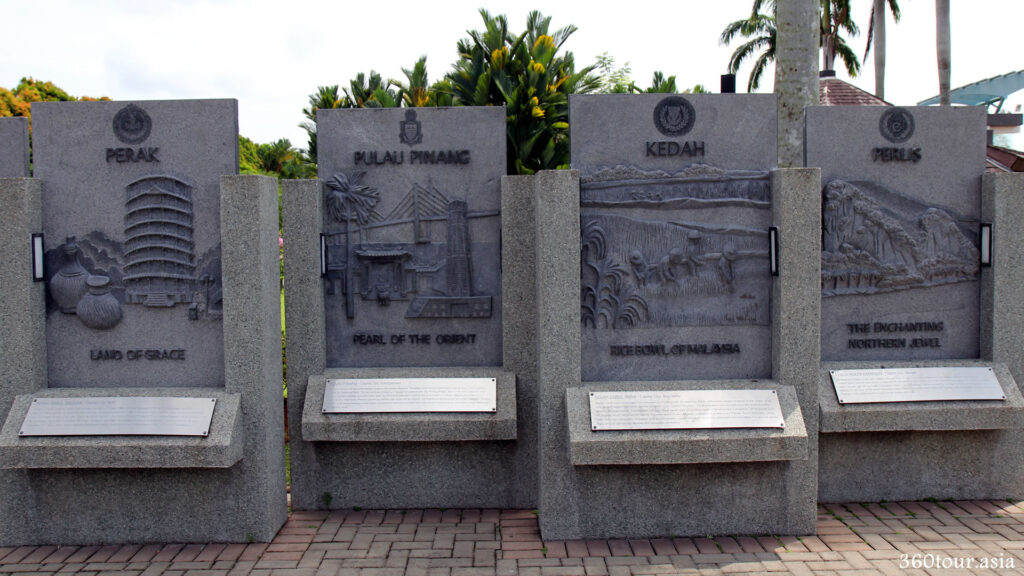
From the Left : Perak (Land of Grace), Pulau Pinang (Pearl of the Orient), Kedah (Rice Bowl of Malaysia) and Perlis (The Enchanting Northern Jewel)
Perak is also known as “Land of Grace”. The Perak granite carving features renowned Labu Sayong (gourd-shaped) black pottery and Leaning Tower of Teluk Intan. The clock tower is a pagoda style national monument which is constructed in 1885 is 25.5 meters tall and lean towards the southwest.
At the inscription plate below this mural depict the following:
PERAK DARUL RIDZUAN – Capital City : Ipoh
Perak is located along the west coast between the states of Kedah in the north and Selangor in the south. Perak was famed for its rich tin deposits. Perak derived its name from the silvery tin. Tin played a prominent role in the state’s history and economy which influenced the influx of Chinese miners to the state. Due to its rich tin deposits, the history of Perak constantly faced outside threats to its sovereignty, from the Achenese in pre-1500, to Melaka, the Dutch, the Bugis, the Thais, the Chinese miners , and the British. It is also noted for its scenic limestone hills, caves, lakes, forest reserves, wildlife sanctuaries, historical places, archeological sites and rich cultural heritage.
Pulau Pinang is also known as “Pearl of the Orient”. The Pulau Pinang granite carving features the Pinang Palm tree, the Penang Bridge, Chinese Temple and Komtar Tower. The Pinang Palm tree is also known as Areca Nut Palm or Betel Palm. The Penang Bridge connects Perai on the mainland side of the state across the Penang Strait to Gelugor on the island. The bridge is the second-longest bridge in Malaysia with a length of 8.4 kilometers over water. Komtar Tower however is constructed in 1974 and completed in 1986, is the tallest skyscraper in Penang.
At the inscription plate below this mural depict the following:
PULAU PINANG – Capital City : Georgetown
Penang Island is off the north-western coast of Peninsular Malaysia. The state comprises an island and a narrow strip on the mainland known as Seberang Perai. The two parts are linked by a regular ferry service and the Penang Bridge. Much of its charm also lies in its famous golden beaches and calm warm seas. Its multiracial population contributes to its wealth of cultural attractions and festival celebrations. Historically, Penang played key pivotal roles to the social, cultural and intellectual development of modern Malaysia. Penang has the most active heritage conservation movement in Malaysia and their work has ensured Penang as an interesting Tourist destination for years to come.
Kedah is also known as “Rice Bowl of Malaysia”. The Kedah granite carving features the scene of a wide open paddy field. The rice production of Kedah accounting for about half of Malaysia’s total production of rice.
At the inscription plate below this mural depict the following:
KEDAH DARUL AMAN – Capital City : Alor Setar
Kedah’s fertile land encourages rice cultivation and together with its neighbour, Perlis, is Malaysia’s largest producer of rice. Kedah is the most ancient state in the country and the Sultanate is the oldest in the region. It is a state which has remnants from the Hindu-Buddhist period in Malaysia history. Predominantly an agricultural-based state, it is undergoing rapid development in all sectors. Off the Kedah coast, is Langkawi which comprises 99 islands. The main island, Pulau Langkawi, is developed as Malaysia’s Premier Tourist destination, since 1990 with major attractions, increased hotel accommodation, major exhibition/ convention centre and duty-free status. It is also the site for the bi-annual International Maritime and Aerospace exhibitions.
Perlis is also known as “The Enchanting Northern Jewel”. The Perlis granite carving features the scene of various Limestone Mountains in Perlis which rise up majestically from the flat ground.
At the inscription plate below this mural depict the following:
PERLIS INDERA KAYANGAN – Capital City : Kangar
Bordered by Thailand in the north, Kedah in the east, and fronting the Straits of Malacca on its western coastline, Perlis exudes quaint unspoilt beauty and old rustic charm. It originally formed part of Kedah, but with the Thais influence it was separated in 1821 as a vassal state in its own right. By the Treaty of Bangkok (1909), it was transferred to British suzerainty, and later become part of the Federation od Malaya. Its land area of 795 square kilometres makes Perlis the smallest state in Malaysia, however, with its strategic location adjacent to Thailand, it has great potential in cross border tourism and trade.
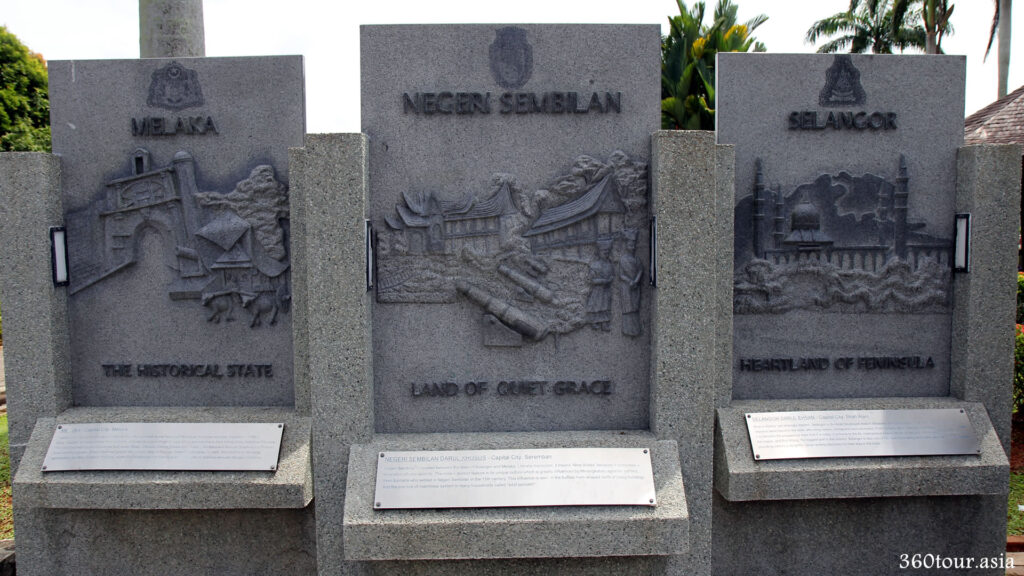
From the Left : Melaka (The Historical State), Negeri Sembilan (Land of Quiet Grace), Selangor (Heartland of Peninsula)
Melaka is also known as “The Historical State”. The Melaka granite carving features the historic A Famosa (former Portuguese fortress) gate house – Porta de Santiago – with its fort canon, and the unique Traditional Bullock Cart in Melaka with curved rooftop.
At the inscription plate below this mural depict the following:
MELAKA – Capital City : Melaka
Melaka is renowned as the place where much of the recorded feudal history of Peninsular Malaysia occurred. Founded in 1396 by Parameswara, an exiled prince from Sumantra, it thrived as a port-of-call to many ships and merchants from China, India, Arabia and Europe. The historical melting-port of cultures and races: Malay, Chinese, Chittys (Straits-born Indian), the Baba and Nyonya (Straits-born Chinese), Dutch and Portuguese. It has influenced greatly the cultural taste of Malayan creativity and styles. In 1405, Admiral Zheng He came, representing the Ming Emperor of China, which first established the friendship and inter cultural relations between Melaka and China.
Negeri Sembilan is also known as “Land of Quiet Grace”. The Negeri Sembilan granite carving featuring the Negeri Sembilan State Museum and Culture Complex with a unique curved roof similar to a buffalo horn which is unique to the Menangkabau People.
At the inscription plate below this mural depict the following:
NEGERI SEMBILAN DARUL KHUSUS – Capital City : Seremban
Negeri Sembilan is located between the state of Selangor and Melaka. Literally translated, it means ‘Nine States’ because it comprises a federation of nine districts. The state’s distinct feature is its unique culture which is greatly influenced by Minangkabau agrarian settlers, from Sumatra who settled in Negeri Sembilan in the 15th century. This influence is seen in the buffalo-horn shaped roofs of many buildings and the practice of matrillineal system in many households called “adat perpatih”.
Selangor is also known as “Heartland of Peninsula”. The Selangor granite carving features the state mosque of Selangor – the Sultan Salahuddin Abdul Aziz Mosque (also known as Blue Mosque). It is the country’s largest mosque and also the second largest mosque in Southeast Asia. It is distinguishable from its large blue and silver dome (largest religious dome in the world) with four minarets (2nd tallest in the world) erected at each of the corners.
At the inscription plate below this mural depict the following:
SELANGOR DARUL EHSAN – Capital City : Shah Alam
Rich in history, yet strikingly modern, Selangor is the most developed state in Malaysia. Its history dates to the 16th century when rich tin deposits were found in the area, attracting miners, immigrants and colonizers. From its early days, Selangor’s strategic position has helped it to become the prosperous state that it is today. It is home to the KL International Airport (KLIA) at Sepang – the most advanced airport in the region, and Port Klang, the biggest port in the country. Selangor is also one of the most fascinating and scenic destinations in Malaysia, providing visitors a delightful, never-ending discovery for their stay in the state.
The China Section of Friendship Park
The China section of the Friendship Park is represented by the Chinese Gateway, Chinese Plaza, Friendship Memorial, KunMin Pavilion, Zigzag bridge, Tea Pavilion, Lily Pond , Beijing Pavilion and the Rock Garden.
Each of different elements the park is strongly signify the culture and architecture uniqueness of the country.
Admiral Zheng He Statue
Admiral Zheng He Statue
The Admiral Zheng He Statue of the Friendship Park is a 20 foot height bronze sculpture that stands on a pedestal on a ship like platform. The statue is facing the direction of South East, signify the travel of the Admiral towards the Southeast Asia. The statue portrays the Admiral Out reach his right hand with a stance of friendliness towards the Malaysia. In front of the statue is the Malaysia Mural and the Sarawak Fountain.
The Admiral is wearing a traditional Chinese Admiral Attire with a cape behind. It shows the status quo and the power of the wearer. In front of the robe is a Dragon motif. He also bears a Chinese Long Sword on his belt (at the back) and holding a huge scrolls on his left hand in front, signify a friendly diplomatic solution.
The Admiral Zheng He Statue is dedicated to the friendship between Malaysia and The People’s Republic of China.
This Statue is sponsored by China Yunnan Road and Bridges Sdn. Bhd.
Over some time, the details of the sculpture is not as prominent as when it was first constructed due to erosion and rust from the rain and sun.
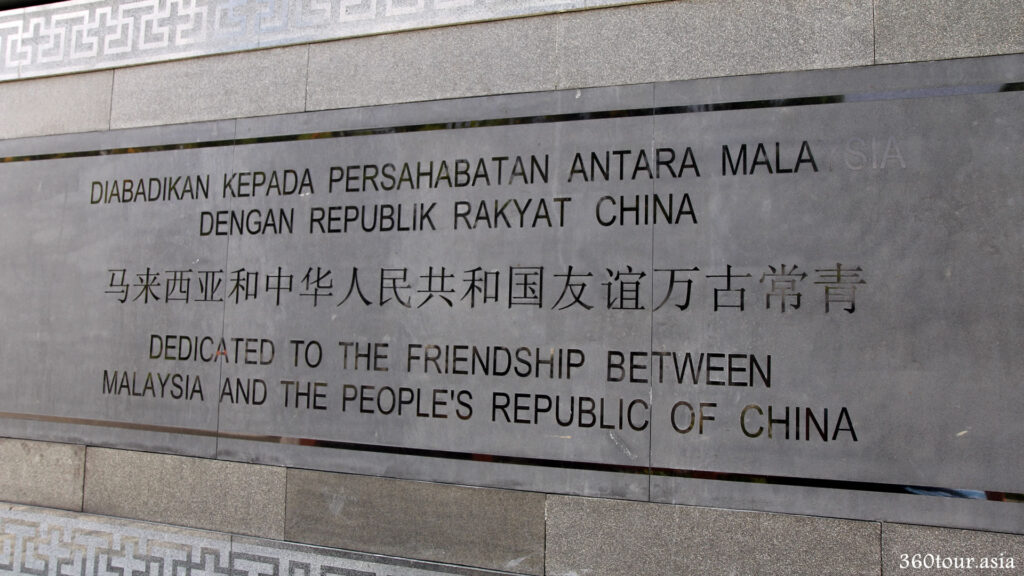
The Admiral Zheng He Statue is dedicated to the friendship between Malaysia and The People’s Republic of China.
At the inscription plate below this statue depict the following:
THE VOYAGES OF ADMIRAL ZHENG HE
Zheng He, known locally as Cheng Ho, 1371-1433, was an admiral, diplomat and explorer during China’s Ming dynasty. “Ma He”, as he was originally known, was born in 1371 to a poor ethnic Hui (Chinese Muslims) family in Yunnan Province, Southwest China. Emperor Yong Le selected him to lead the first of seven epic expeditions (1405-1433) to South East Asia.
Zheng He started the world’s first biggest naval expedition in 1405, about a century ahead of Christopher Columbus. His fleet consisted of over 300 ships with over 60 treasure ships measuring 150 metres in length and 83 metres in width and equipped with more than 28,000 crew. Zheng He made one last voyage (1431-1433) during the regin of Emperor Zhu Zhanji when his fleets visited more than 37 countries in the South China Sea, Indian Ocean, Arabian Sea, Mediterranean Sea and Africa. All in all Zheng He made seven voyages within a period of 23 years.
According to the Malay Annals, Zheng He escorted a contingent of 500 court maidens together with a princess called Hang Li Po to marry the Sultan Mansur Syah of Malacca. They eventually settled in Bukit Cina in Malacca. The male and female descendants of these people from mixed marriages with the local natives are known today as “Baba and Nyonya” respectively.
Junks is the term called for the Ancient Chinese Ship that were used as seagoing vessels. It was seen as early as 2nd century AD and developed rapidly during Song Dynasty (960-1279). The largest junks, the treasure ships commanded by Ming Dynasty Admiral Zheng He, were build for world exploration in the 15th century.
The Man-made lake behind the Admiral Zheng He Statue signify the “Ocean” that the Chinese Junk had go across from the China side before “embark” on the Malaysian side.
Friendship Memorial Chinese Gateway
Friendship Memorial Chinese Gateway
The Friendship Memorial Chinese Gateway is located at the Chinese section Main Entrance of the friendship park. Also known as the Chinese Gateway, it is a massive timber-concrete Chinese themed arch gate. It features a pair of Qilin (麒麟) at the inner pedestal, a pair of Imperial guardian lions at the outer pedestal, Layers on layers of crossing beams with colorful Chinese motif, fine carved arch ornaments, curved edge roofs, ceramic roof tiles, and huge red pillars. A closer looks at the colorful beams may reveal motifs of Dragons, Qilins and Phoenyx, which are all mystical creatures of the Chinese believe. This Gateway is a landmark of its own, projecting the creative and symbolism of the Chinese culture.
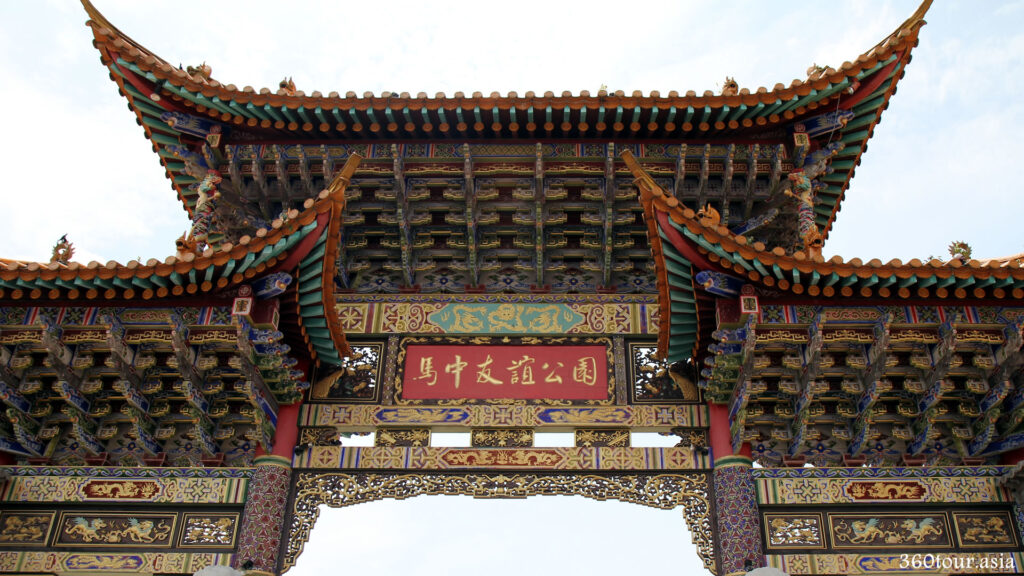
The close up view of Chinese Gateway features colorful beams with Chinese motifs, finely carved arch ornaments and the curve roofs.
Stone Lions (石獅)
From the front of the gateway (facing the road) features a pair of Chinese guardian lions which also known as Stone Lions (石獅), Imperial guardian lions or Foo Dog (in the west). This pairs come with a male Guardian Lion on the right (leaning his paw upon an embroidered ball representing supremacy) and a female Guardian Lion (restraining a playful cub that is on its back representing nurture).
These guardian lions are usually seen as pairs at entrance of Hotels, Imperial Courts, Chinese Palace, Houses and Shopping Malls. It is usually fine carved enblock from granite stone or marble, some are iron or bronze casted, modern ones are usually build from concrete. It used to representing the status quo of the occupancy, to stable yin and yang, to bring good feng shui, or some use for decorative purpose.

Chinese Guardian Lions at the Chinese Gateway of Friendship Park. This male Guardian Lion holding a embroidered ball.
Qilin (麒麟)
From the back of the gateway (facing away from the road) features a pair of Chinese mystical lions which also known as Qilin (麒麟)
Qilin is a mystical chimerical creature known in Chinese and other East Asian cultures. It depicts a chimerical creature with the head of a dragon, the antlers of a deer, the skin and scales of a fish, the hooves of an ox and tail of a lion.
Qilin was described as early as Jin dynasty of China, also in Ming and Qing dynasty. Although there is variation in description of the creature in different dynasty, but the main features of Dragon head and powerful hooves.
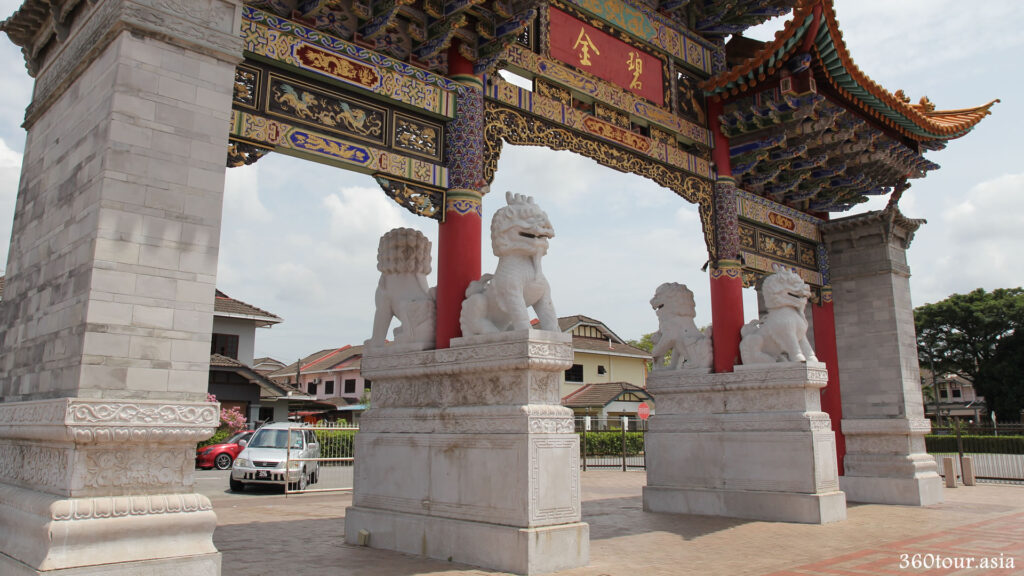
The Pairs of Stone Qilin Statue at the internal section of the Main Entrance of the Chinese Gateway.
Friendship Memorial
Friendship Memorial
It is located beside the Chinese Gateway. This Memorial features a small classical Chinese pavilion with red wooden pillars and beams, Curved ceramic roof and three marble inscripted tablets in three different language – Chinese, English and Malay.
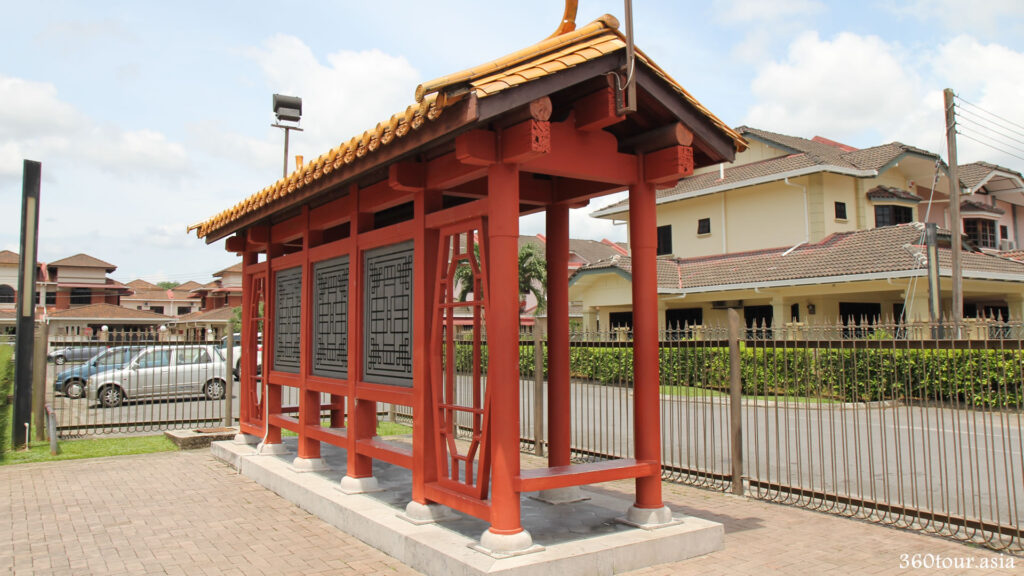
This Friendship Memorial is appears more like a small pavilion with a inscription on three marble tablet stating the brief history of this memorial.
The inscription on the Friendship Memorial :
The establishment of a Malaysia China Friendship Park in Kuching by the Council of the City of Kuching South and the Kunming Municipal People’s Government Yunnan Province, China, symbolizes the flourishing friendship of the people of these two Cities and the exchange of their political, economic and cultural ties.
The Kunming Municipal People’s Government constructed an ancient like Chinese Garden, a Zheng He statue and a hexagonal pavilion called “Huai Feng Pavilion” to commemorate the former glory of Admiral Zheng He.
With the historical and lasting friendship between Malaysia and China we look forward to a bright future for the people of Kuching and Kunming.
30th September 2005
Chinese Plaza
Chinese Plaza
Plaza is a open public square that allows various activity to be held with the public. The Chinese Plaza of friendship park is a moderate large open space between the Chinese Gateway and the Tea Pavilion. On the ground, the bricks are carefully lined and arrange to form a two tone Chinese Motifs in the center of the Plaza.
At the evenings you can see people jogging and roaming around the plaza. In some days you can also see people practicing Tai Chi on this plaza. Occasionally people use this plaza for events.
Panda and the Cat Statue
Panda and the Cat Statue
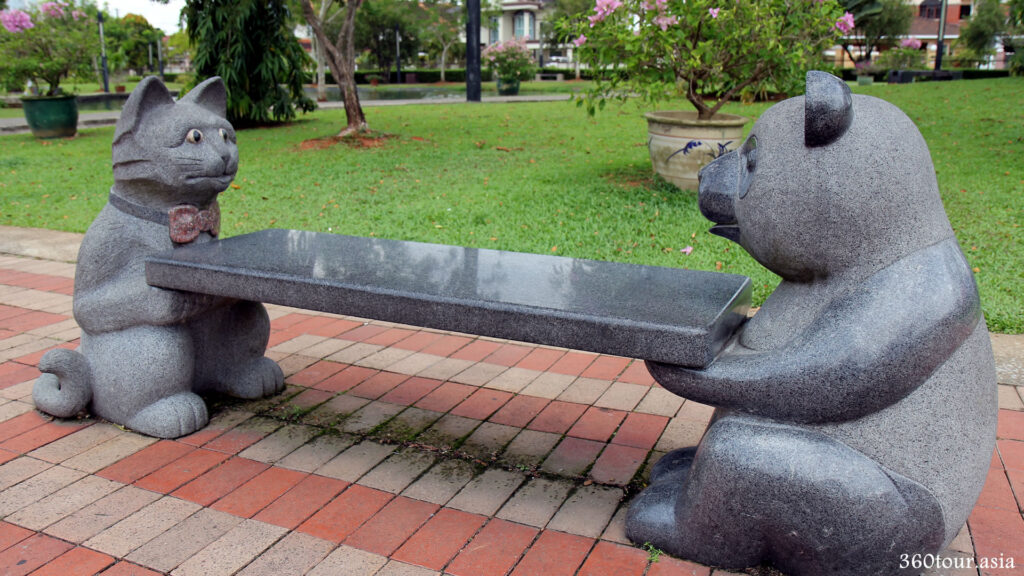
The Cat statue on the Left and Panda statue on the Right. Both holding to form the unique garden stone chair.
We had seen the Orang Utan and the Panda statue from the Malaysian section of the Friendship Park, which signify the friendship between the two nations.
There is also another similar statue that share the same meaning, which is the cat and panda statue. The cat symbolize Kuching City (Kuching is a Malay word for Cat), while Panda symbolize China.
The meaning to this statue is clearly stated in the Friendship Memorial of the park. This park is a build on collaboration of Council of the City of Kuching South and the Kunming Municipal People’s Government Yunnan Province, China. Hence the friendship between the Cat (Kuching) and Panda (Kunming) stays forever strong.
Tea Pavilion
Tea Pavilion
Tea is a beverage that is derived from the tea plant. The tea drinking customs of Chinese symbolize a sign of respect, family gatherings and to show gratitude and celebration. Tea in China often associated with literature, arts and philosophy with close connection with Taoism, Buddhism and Confucianism.
Teahouse is once used by ancient Chinese scholars as a place to share ideas. People from from different political agenda and status quo will sit down equally in a teahouse as a mutual respect. It promote conviviality and civility.
The Tea Pavilion is a double story building with Chinese architectural designs. This includes ceramic tile roof, curve roof edges, round pillars, wooden windows and doors with Chinese motifs.
This Tea Pavilion building is build in memory of the Late Mr & Mrs Tiong Toh Siong.
The tea pavilion also called as D’tea Pavilion (Restaurant) . It opens on 12:00 – 21:00 on weekdays and 13:30 – 21:00 on weekends. It closed on Wednesday. D’tea Pavilion serves local favourite ice kacang, pizza, dimsum, fried noodles, toast, pastries, desserts and tea.
Visitors can choose to sit in the building or on the balcony. The balcony is build above the waters and visitors are allowed to purchase the fish food available and enjoy seeing thousands of huge koi fishes in the man-made lake rushing for food.
Zig-Zag Bridge
Zig-Zag Bridge
The Zig-zag bridge is a pedestrian bridge composed of short segments, with each set at an angle relative to its neighbour segments. When crossing the bridge, visitors need to make sharp turns multiple times. It is a feature in traditional and contemporary Asian landscape design across water gardens. It is commonly seen in Chinese Gardens, Japanese Garden and Zen rock garden.
The design is based on the Zen principle of mindfulness. The non linear bridge design forcing the user attention on crossing the bridge and at the same time slows down the pace of the user so that he can have the pleasure to enjoy the landscape around.
You can also enjoy your time feeding the fishes in the pond from the Zig-zag Bridge. You will encounter colorful huge Koi fishes in the center portion of the lake.
Rock Garden
Rock Garden
The Rock Garden is located at the Chinese section of the friendship park, in between the Tea Pavilion and the Beijing Pavilion. The main feature of this Rock Garden is series of sharp irregular Limestone Rock, big and small, along the reflexology stone path.
Limestone rock formation is well known to form amazing nature wonders in the stony mountain ridge in many part of the world. Natural Limestone rocks are shaped by rain and sun, forming unique creases and projections, which add irregularity beauty to the surroundings. Green plants are planted around the rocks to add harmony and contrast to the Garden.
In some Chinese houses who is focused on good feng shui, rocks are placed at the front yard or center garden to bring stability to the feng shui outline.
The Reflexology Foot Path is a walking path with smooth river stone projection embedded . It is designed to message and stimulate acupressure points on the soles of the foot, which are connected to various energy meridians of the body. The main purpose is to create health and well-being.
Tao Ran Pavilion (Beijing Pavilion)
Tao Ran Pavilion (陶然亭)
The Tao Ran Pavilion (陶然亭) also known as Beijing Pavilion. This traditional Chinese pavilion is created based on traditional architecture from Beijing area China. One thing to be noted is Taoran Pavilion Park is a city park located in Xicheng District in Beijing.
This round pavilion features exposed colorful beams with Chinese motifs, curve ceramic roof and huge red pillars. Red is the major color, as Red signifies Good Luck and Joy in Chinese culture. The round pavilion have its meaning of unity and harmony.
The Beijing Pavilion is adjacent to the Rock Garden allows user to have a rest after a walk at the Reflexology Foot Path.
Huai Feng Pavilion (Kunming Pavilion)
Huai Feng Pavilion (怀风亭)
The Huai Feng Pavilion (怀风亭) also known as KunMing Pavilion. This traditional Chinese pavilion is created based on traditional architecture from Kunming area China. Kunming City is located at southern Yunnan province of China. It is a modern city features with many traditional buildings, pavilions and stone bridge around the city.
This Hexagonal shaped pavilion features exposed colorful beams with Chinese motifs, curve ceramic roof, huge red pillars, and wooden carved ornaments around each edge of the pavilion. There is wind chimes around each corners of the roof, which as the name “Huai Feng” suggested. It means “to think of the Wind” or just “memories in the wind”. Red is the major color, as Red signifies Good Luck and Joy in Chinese culture.
This Huai Feng Pavilion based on architecture from Kunming area, which is much different from another Chinese Garden Pavilion which is at the other side of the park which is based on architecture from Beijing.
Don’t forget to visit this meaningful park when you visit Kuching City.
